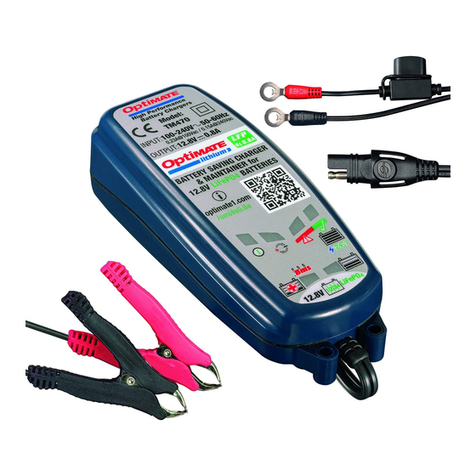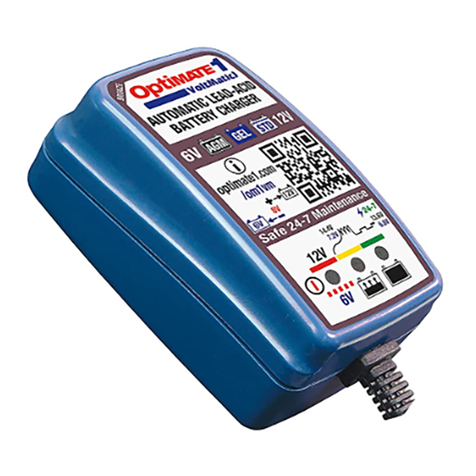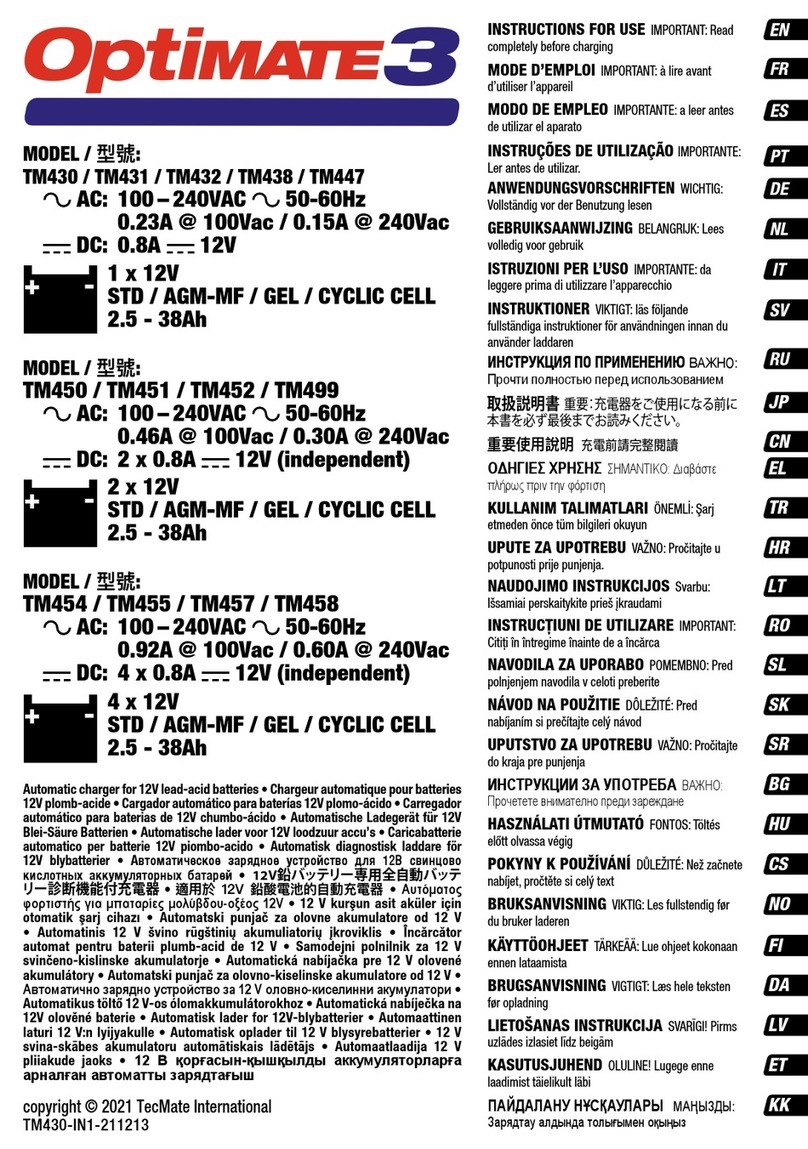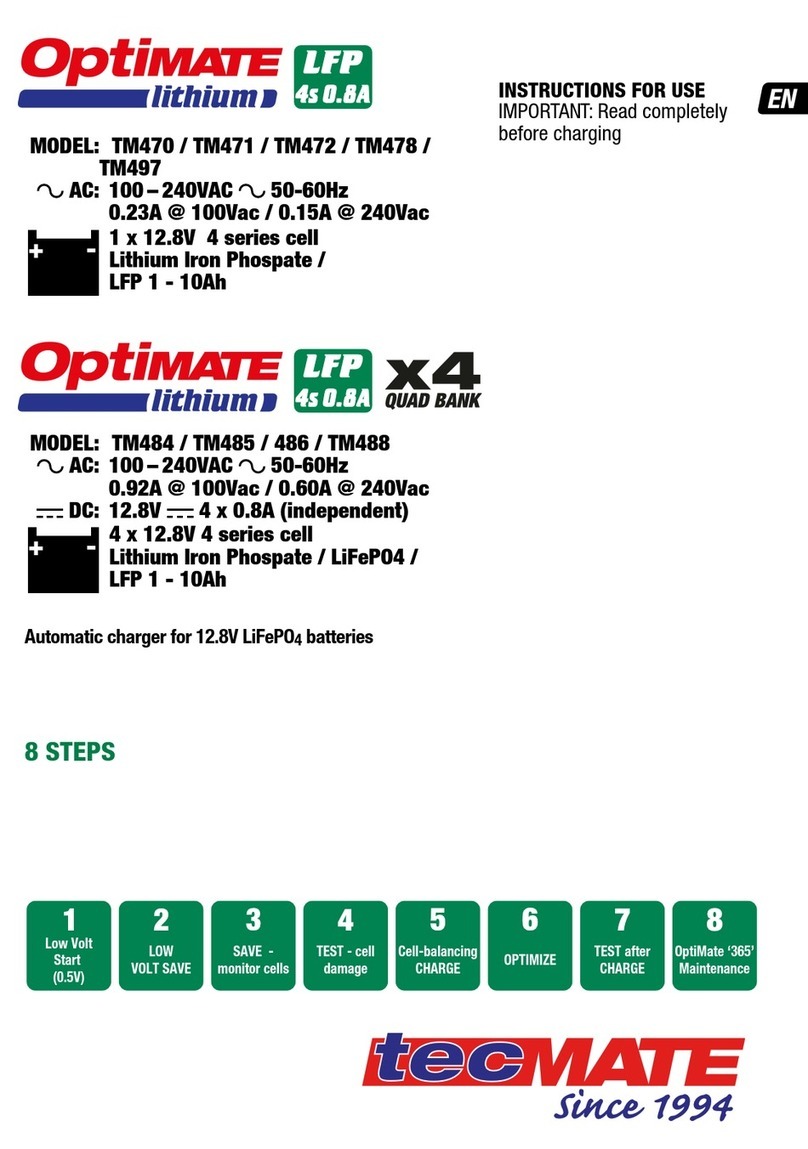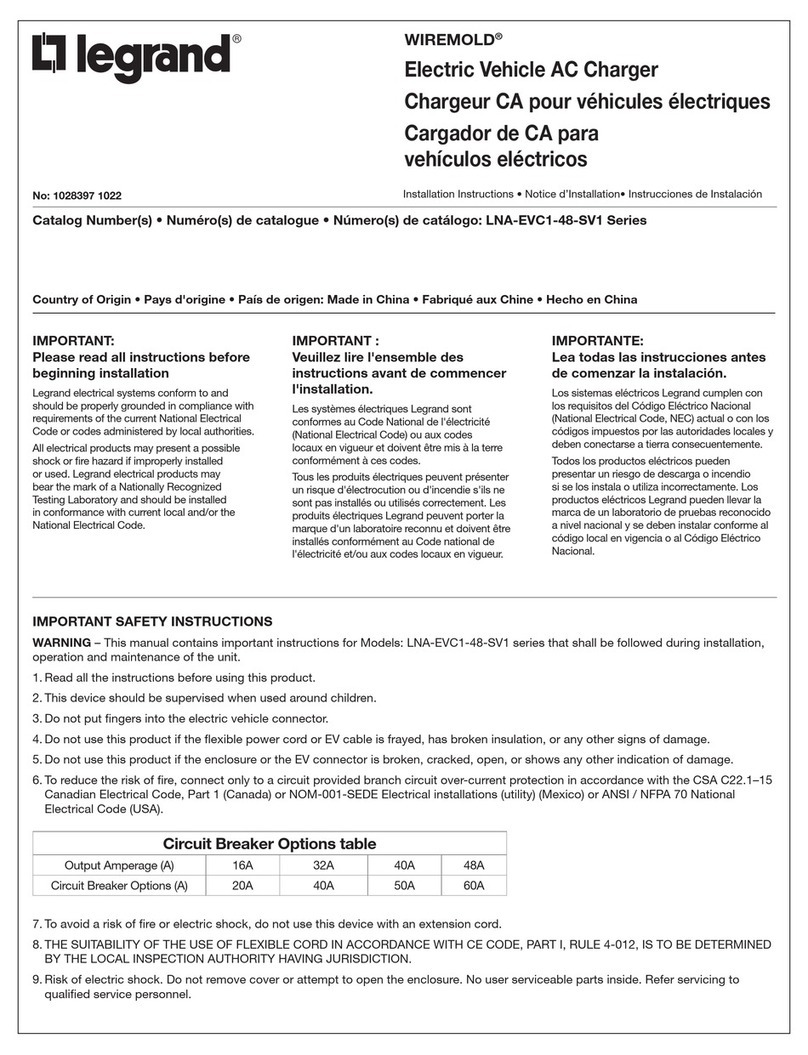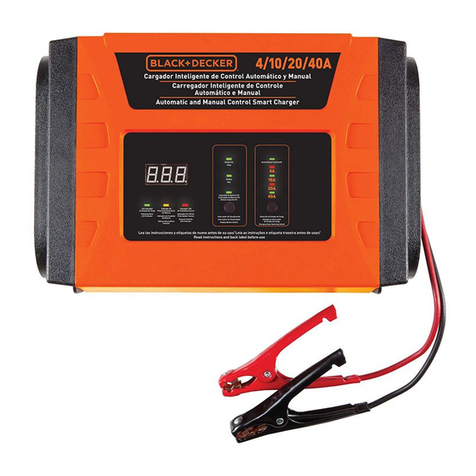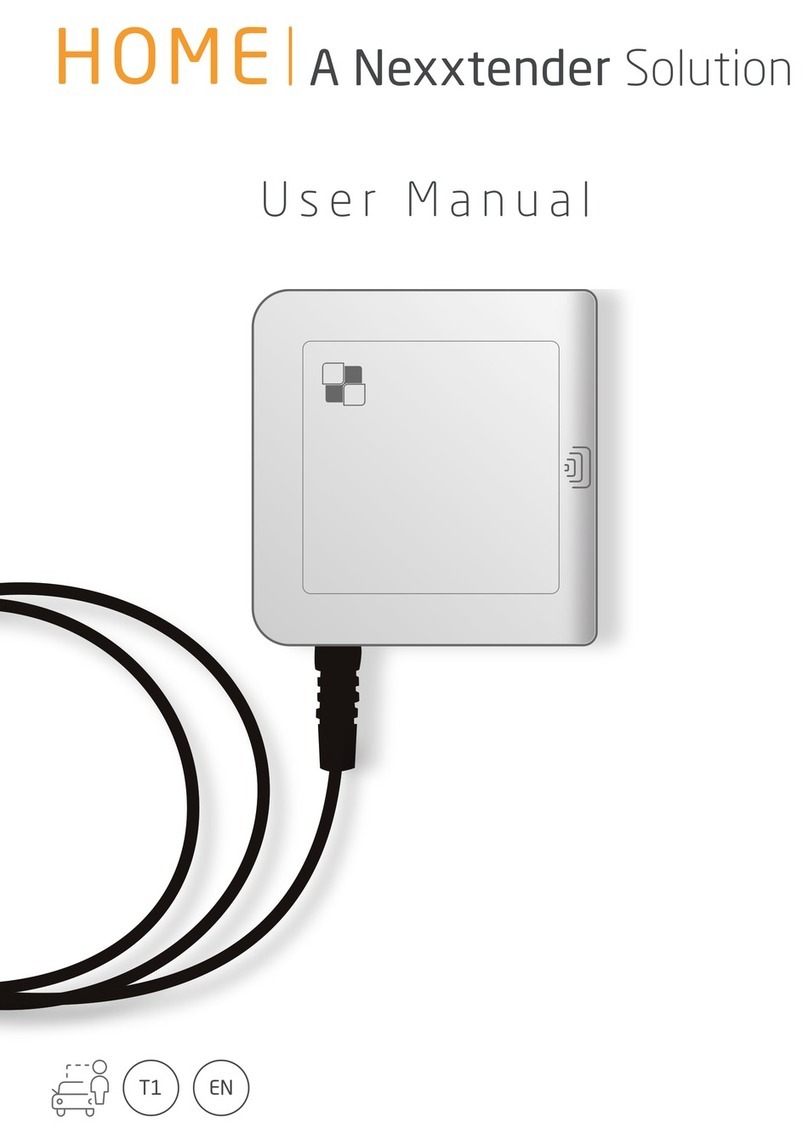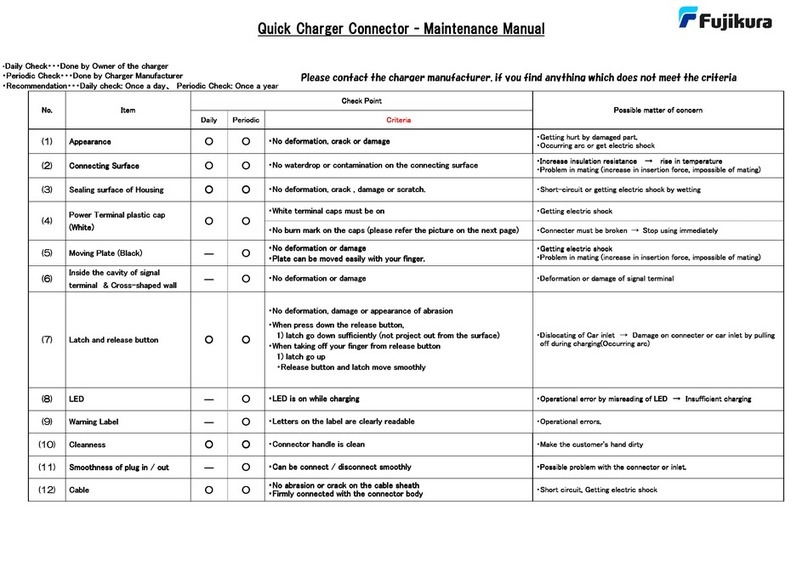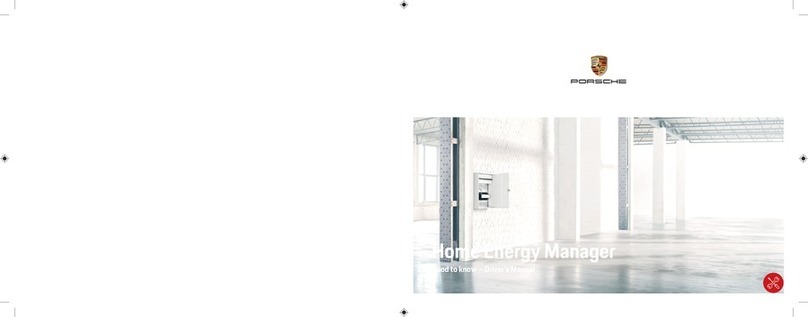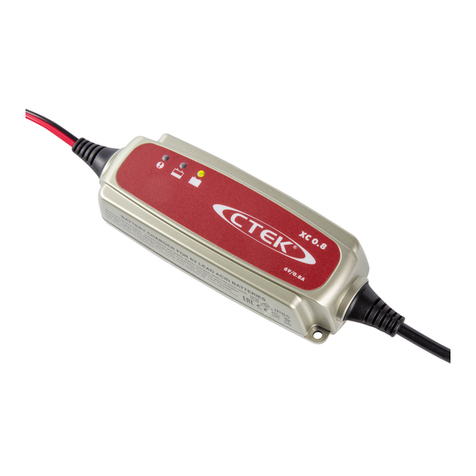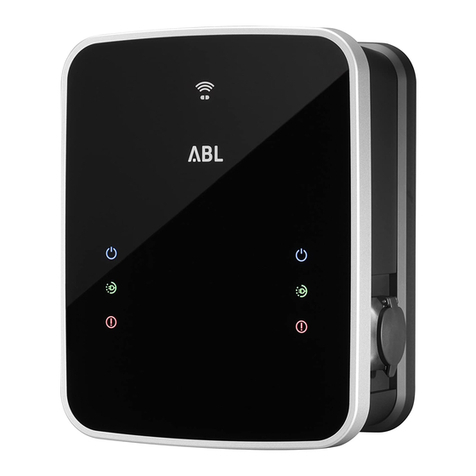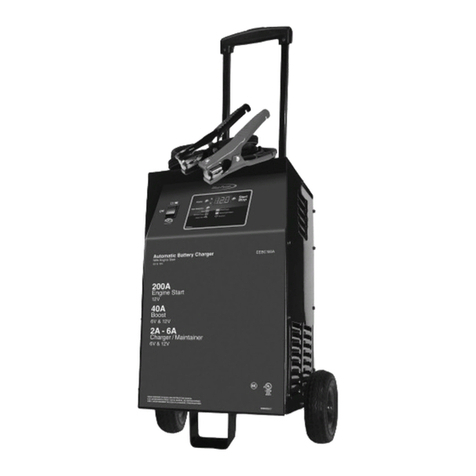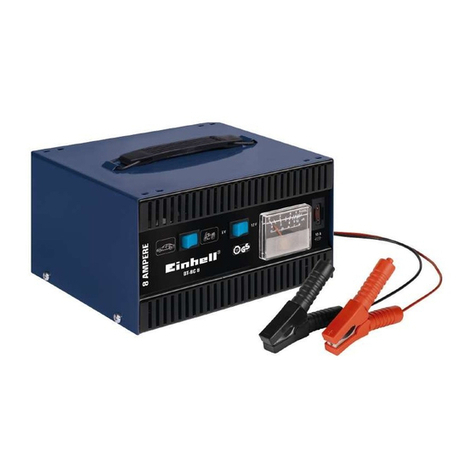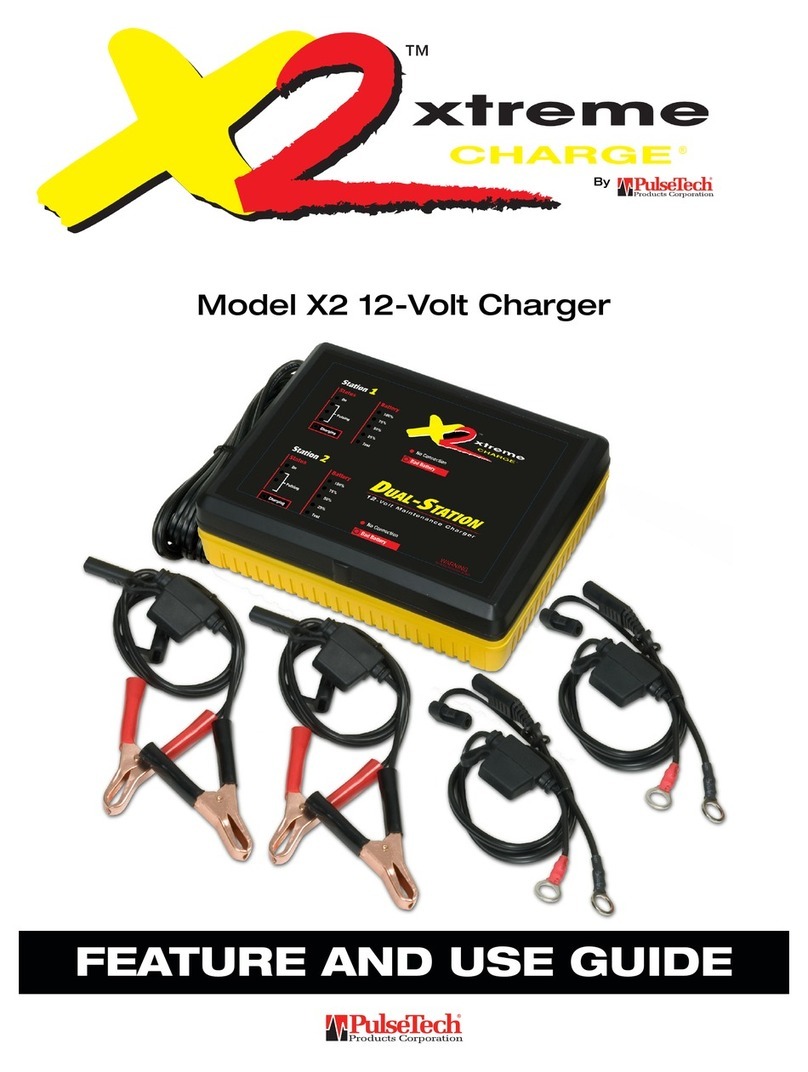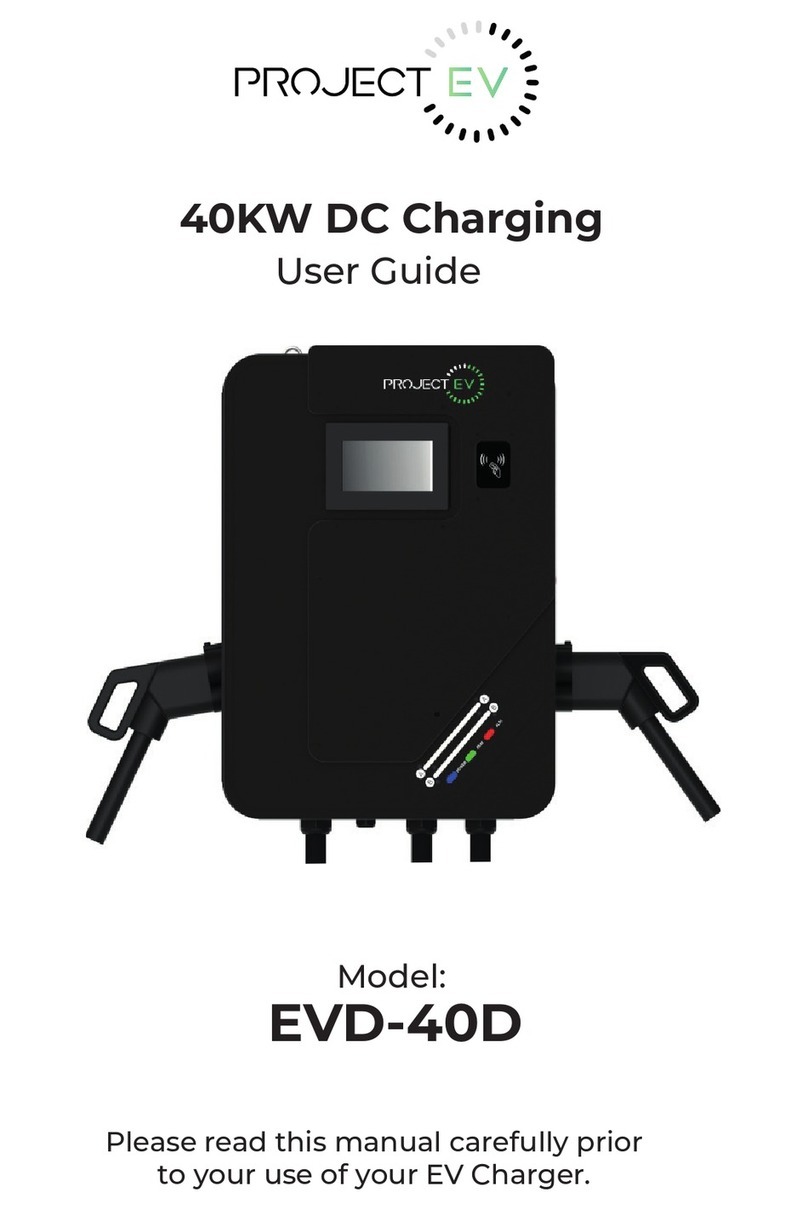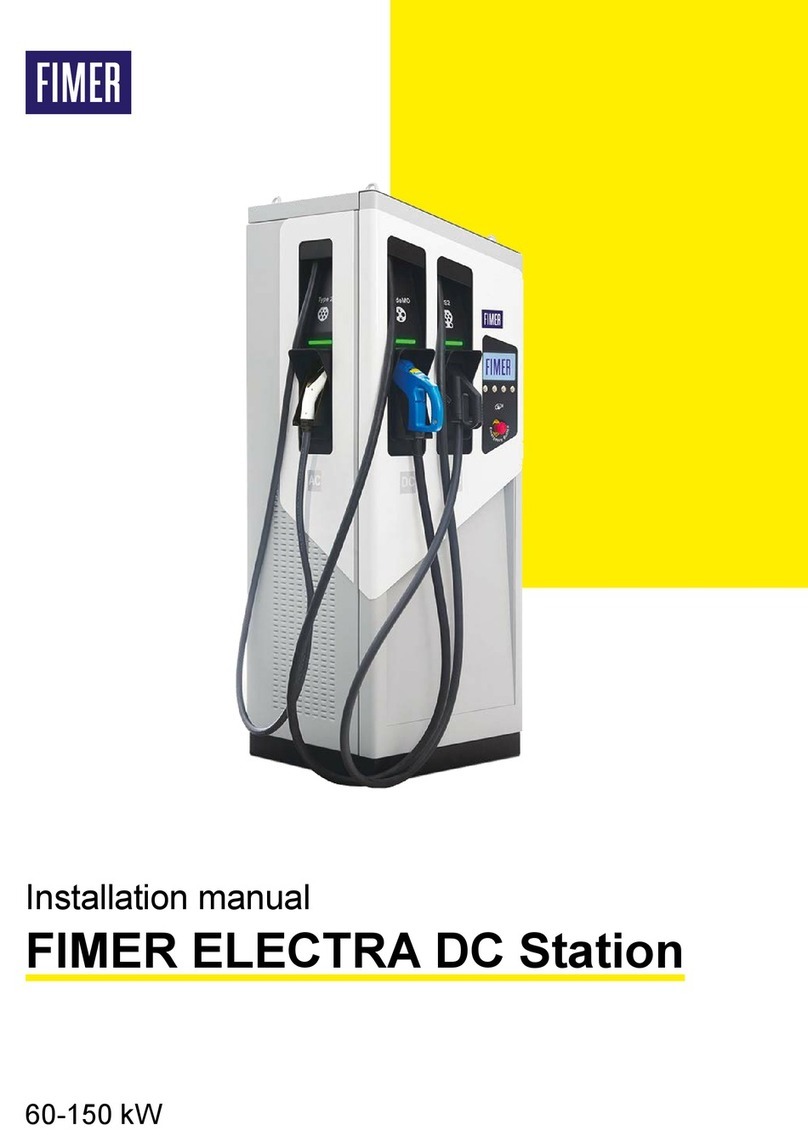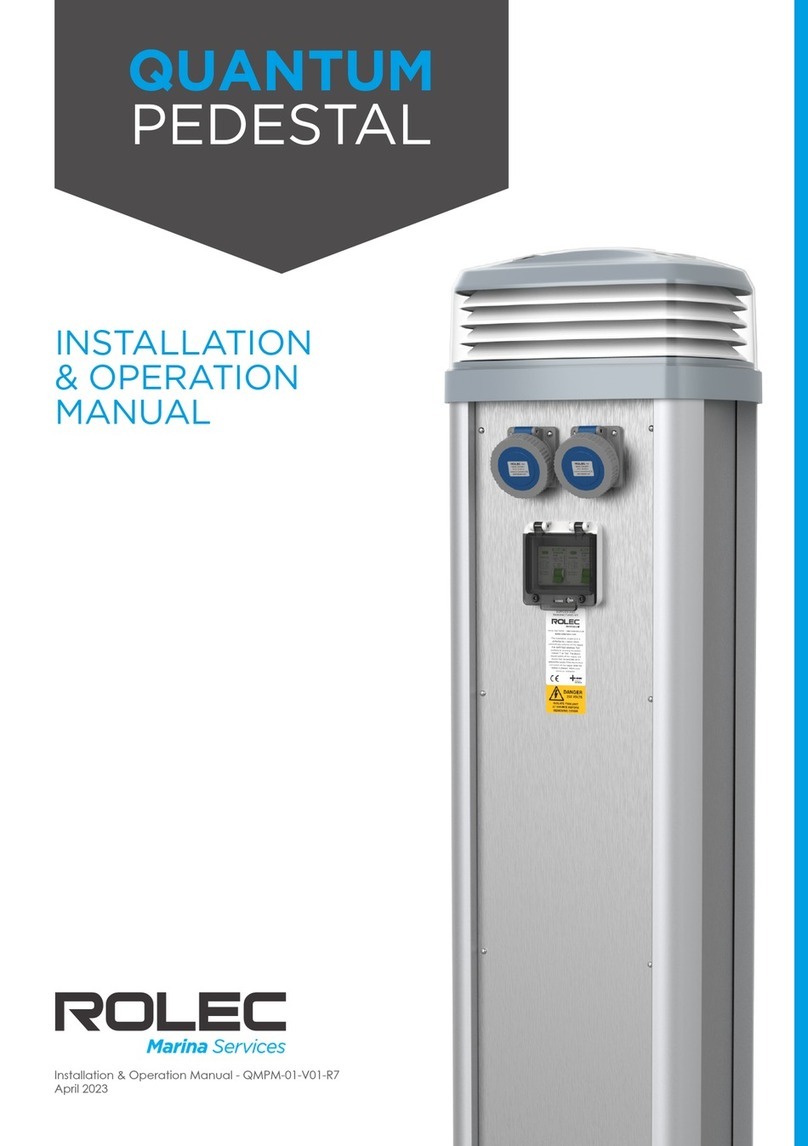TecMate Optimate TM270 User manual

Automatic charger for 12.8V & 16V LiFePO4batteries : Chargeur
automatique pour batteries 12.8V & 16V LiFePO4: Cargador automático
para baterías 12.8V & 16V LiFePO4: Carregador automático para baterias
de 12.8V & 16V LiFePO4: Automatisches Ladegerät für 12.8V & 16V
LiFePO4Batterien : Automatische lader voor 12.8V & 16V LiFePO4accu’s :
Caricabatterie automatico per batterie 12.8V & 16V LiFePO4: Automatisk
diagnostisk laddare för 12.8V & 16V LiFePO4-batterier
MODEL: TM270 / TM271 / TM272
AC: 100 – 240VAC 50-60Hz
0.66A @ 240VAC 1.59A @ 100VAC
DC: 120W 12.8V 9.5A / 16V 7.5A
Thermally adjusted
INSTRUCTIONS FOR USE
IMPORTANT: Read completely
before charging
MODE D’EMPLOI
IMPORTANT: à lire avant
d’utiliser l’appareil
MODO DE EMPLEO
IMPORTANTE: a leer antes de
utilizar el aparato
ANWENDUNGSVORSCHRIFTEN
WICHTIG: Vollständig vor der
Benutzung lesen
GEBRUIKSAANWIJZING
BELANGRIJK: Lees volledig voor
gebruik
INSTRUÇÕES DE UTILIZAÇÃO
IMPORTANTE: Ler antes de
utilizar.
ISTRUZIONI PER L’USO
IMPORTANTE: da leggere prima
di utilizzare l’apparecchio
INSTRUKTIONER
VIKTIGT: läs följande fullständiga
instruktioner för användningen
innan du använder laddaren
16V / 5s LiFePO4/ Lithium Ferrous
Phosphate 2Ah <-> 100Ah
1 2 3 4 5
12.8V / 13.2V / 4s LiFePO4/ Lithium
Ferrous Phosphate 2Ah <-> 120Ah
1 2 3 4
copyright © 2020 TecMate International – TM270-IN1-201212

LEDs - OptiMate Lithium LFP Select
2
1
2
.
8
V
1
6
V
B
M
S
r
e
s
e
t
16V
24-724-7
BmsBms
12.8V
12.8V LFP
LiFePO4
1 2 3 4 1 2 3 4 5
16V
/oml12.8v16v
optimate1.com
/oml12.8v16v
5
4
3
1a 1b 2 8
6
7
90 100%603010%
13.3V 13.6V+ 13.13V13.00V12.8VV
0
0.5V
flashing / clignotante /
intermitente / blinkt /
parpadeando /
knippert / blinkar
876
8776
8
90 100%603010%
13.3V 13.6V+ 13.13V13.00V12.8VV
0
0.5V
flashing / clignotante /
intermitente / blinkt /
parpadeando /
knippert / blinkar
876
8776
8
BMS
12.8V 16V
1 2 3 4
BMS reset / Low Volts
1 2 43 5
3s
+
V?
12.8V
16V
90 100%603010%
16.63V 17.0V+ 16.41V16.25V16.0VV
0
0.5V
flashing / clignotante /
intermitente / blinkt /
parpadeando /
knippert / blinkar
876
8776
8
SOC % - 12.8V
SOC % - 16V
°t
(°F)
°t
(°C)
Ampére (A)
32 113
14 31
-4 13
114 131
131
-5
0 45
46 55
56
-10 0
-20 -10
-21
10 (7.5 at 16V)
2.5
1.25
0
2.5
0
safe°T

1
IMPORTANT SAFETY
INSTRUCTIONS FOR CANADA & USA
SAVE THESE INSTRUCTIONS.
AUTOMATIC CHARGER ONLY FOR 12.8V / 16V
LiFePO4
(LITHIUM FERROUS
PHOSPHATE / LITHIUM IRON PHOSPHATE) BATTERIES.
DO NOT USE FOR NiCd, NiMH, Lead-Acid or any other type of Li-Ion or
NON-RECHARGEABLE BATTERIES.
*IEC62133 - Safety requirements for portable sealed secondary cells containing alkaline or other
non acid electrolytes and for batteries made from them, for use in portable applications.
1. CAUTION : DO NOT CONNECT TO GROUND.
2. For indoor use only. Do not expose charger to rain or snow.
3. Use of an attachment not recommended or sold by the battery charger manufacturer may result in a risk of fire, electric
shock,or injury to persons.
4. To reduce risk of damage to electric plug and cord,pull by plug rather than cord when disconnecting charger.
5. An extension cord should not be used unless absolutely necessary. Use of improper extension cord could result in a risk of
fire and electric shock.If extension cord must be used make sure that :
a) pins on plug of extension cord are the same number, size and shape as those of plug on charger, b) the extension cord is
property wired and in good electrical condition,and c) the conductor wire size is large enough for the AC ampere rating of
the charger as specified in the table below.
AC INPUT RATING IN AMPERES
Equal to or greater than But less
than
LENGTH OF
CORD, FEET (m) AWG
SIZE OF
CORD
2A 3A 25 (17.6)
50 (15.2)
100 (30.5)
18
18
14
6. Do not operate charger with damaged cord or plug - replace the cord or plug immediately.
7. Do not operate charger if it has received a sharp blow, been dropped,or otherwise damaged in any way; take it to a
qualified serviceman.
8. Do not disassemble charger; take it to a qualified serviceman when service or repair is required.
Incorrect reassembly may result in a risk of electric shock or fire.
9. To reduce risk of electric shock, unplug the charger from outlet before attempting any maintenance or cleaning.
Turning off controls will not reduce this risk.Clean only with slightly moist,not wet, cloth.Do not use solvents.
10. warning - risk of explosive gases. a) working in vicinity of a lead-acid battery is dangerous. Batteries generate explosive
gases during normal battery operation. for this reason, it is of utmost importance that you follow the instructions each time
you use the charger. b) To reduce risk of battery explosion,follow these instructions and those published by the battery
manufacturer and manufacturer of any equipment you intend to use in vicinity of the battery. Review cautionary marking on
these products and on engine.
11. PERSONAL PRECAUTIONS.
a) Someone should be within range of your voice OR close enough to come to your aid when you work near a battery. b)
Have plenty of fresh water and soap nearby in case battery acid contacts skin, clothing or eyes. c) Wear complete eye
protection and clothing protection. Avoid touching eyes while working near a battery. d) If battery acid contacts or enters
eye, flood eye with cold running water for at least 10 minutes and get medical attention immediately. If battery acid contacts
skin or clothing, wash immediately with soap & water. If acid enters an eye , immediately flood eye with running cold water
for at least 10 minutes & get medical attention immediately. e) NEVER smoke or allow a spark or flame in vicinity of battery
or engine. f) Be extra cautious to reduce risk of dropping a metal tool onto battery. It might spark or short-circuit battery or
other electrical part that may cause explosion. g) Remove personal metal items such as rings, bracelets ,necklaces , and
watches when working with a battery. A battery can produce a short-circuit current high enough to weld a ring or the like to
metal, causing a severe burn. i) NEVER charge a frozen battery.
12. PREPARING TO CHARGE
a) If necessary to remove battery from vehicle to charge,always remove grounded terminal from battery first.

2
Make sure all accessories in the vehicle are off, so as not to cause an arc.
b) Be sure area around battery is well ventilated while battery is being charged. Gas can be
forcefully blown away by using a piece of cardboard or other non-metallic material as a fan.
c) Clean battery terminals.Be careful to keep corrosion from coming in contact with eyes. d) Study all battery
manufacturer’s specific precautions such as removing or not removing cell caps while charging and recommended rates of
charge. e) Determine voltage of battery by referring to vehicle or other user’s manual and before making the battery
connections, make sure that the voltage of the battery you are going to charge matches the output voltage of the charger.
13. CHARGER LOCATION.
a) Locate charger as far away from battery as DC cables permit.
b) Never place charger directly above batterv being charged;
gases from battery will corrode and damage the charger. c) Never allow battery acid to drip on charger when reading gravity or
filling battery. Do not operate charger in a closed-in area or restrict ventilation in any way.
d) Do not set a battery on top of charger. IMPORTANT : Place charger on a hard flat surface or mount onto a vertical surface.
Do not place on plastic, leather or textile surface.
14. DC CONNECTION PRECAUTIONS
a) Connect and disconnect DC output clips only after removing AC cord from electric outlet. Never allow clips to touch each
other, however should this happen no damage will result to the charger circuit & the automatic charging programme will just
reset to «start». b) Attach clips to battery and chassis as indicated in 15(e), 15(f), and 16(b) through 16(d).
NOTE : This battery charger has an automatic safety feature that will prevent it from operating
if the battery has been inversely connected.
Remove AC cord from electrical outlet, disconnect the battery clips, then reconnect correctly according to the instructions
below.
15. FOLLOW THESE STEPS WHEN BATTERY IS INSTALLED IN VEHICLE. A SPARK
NEAR A BATTERY MAY CAUSE BATTERY EXPLOSION. TO REDUCE RISK OF A
SPARK NEAR BATTERY :
a) Position AC and DC cords so as to reduce risk of damage by hood, door or moving engine part. b) Stay clear of fan
-blades, belts,pulleys,and other parts that can cause injury to persons. c) Check polarity of battery posts.POSITIVE (POS, P,
+) battery post usually has larger diameter than NEGATIVE (NEG, N,–) post. d) Determine which post of battery is grounded
(connected) to the chassis. If negative post is grounded to chassis (as in most vehicles),see (e). If positive post is grounded to
the chassis,see (f). e) For negative-grounded vehicle, connect POSITIVE (RED) clip from battery charger to POSITIVE (POS, P,
+ ) ungrounded post of battery. Connect NEGATIVE (BLACK) clip to vehicle chassis or engine block away from battery. Do not
connect clip to carburetor, fuel lines, or sheet-metal body parts. Connect to a heavy gage metal part of the frame or engine
block. f) For positive-grounded vehicle, connect NEGATIVE (BLACK) clip from battery charger to NEGATIVE (NEG. N , -)
ungrounded post of battery. Connect POSITIVE (RED) clip to vehicle chassis or engine block away from battery. Do not
connect clip to carburetor, fuel lines, or sheet-metal body parts. Connect to a heavy gage metal part of the frame or engine
block. g) When disconnecting charger, turn switches to off, disconnect AC cord,remove clip from vehicle chassis,and then
remove clip from battery terminal. h) See operating instructions for length of charge information.
16. FOLLOW THESE STEPS WHEN BATTERY IS OUTSIDE VEHICLE. A SPARK NEAR THE
BATTERY MAY CAUSE BATTERY EXPLOSION. TO REDUCE RISK OF A SPARK NEAR
BATTERY :
a) Check polarity of battery posts. POSITIVE (POS, P, +) battery post usually has a larger diameter than NEGATIVE (NEG,N, -)
post. b) This battery charger has an automatic safety feature that will prevent it from operating if the battery has
been inversely connected. The charger does allow charge current unless a voltage of at least 0.5V is sensed.
c) Connect POSITIVE (RED) charger clip to POSITIVE (POS, P, +) post of battery. d) Connect NEGATIVE (BLACK) charger clip to
NEGATIVE (NEG, N, -) battery post of the battery. e) Do not face battery when making final connection.
f) When disconnecting charger, always do so in reverse sequence of connecting procedure & break first connection while as
far away from battery as practical.
g) A marine (boat) battery must be removed & charged on shore. To charge it on board requires equipment specially
designed for marine use.

3
DO NOT USE FOR NiCd, NiMH, Lead-Acid or any other type of Li-Ion or
NON-RECHARGEABLE BATTERIES.
IMPORTANT: READ THE FOLLOWING INSTRUCTIONS BEFORE OPERATING
THIS CHARGER.
This appliance can be used by children aged from 8 years and above and persons with reduced
physical,sensory or mental capabilities or lack of experience and knowledge if they have been given
supervision or instruction concerning use of the appliance in a safe way and understand the hazards
involved. Children shall not play with the appliance. Cleaning and user maintenance shall not be made by
children without supervision.
SAFETY WARNING AND NOTES: BATTERIES EMIT EXPLOSIVE GASES - PREVENT
FLAME OR SPARKS NEAR BATTERIES. CHARGE BATTERY IN A WELL VENTILATED
AREA. Use the charger only if the input and output leads and connectors are in good,
undamaged condition. If the input cable is damaged, it is essential to have it
replaced without delay by the manufacturer, his authorised service agent or a
qualified workshop, to avoid danger. Protect your charger from damp and humid conditions both
during use and in storage. Damage resulting from corrosion, oxidation or internal electrical short-circuiting is not
covered by warranty. Distance the charger from the battery during charging to avoid contamination by or
exposure to acid or acidic vapours. If using it in the horizontal orientation, place the charger on a hard, flat
surface, but NOT on plastic, textile or leather. Use the fixing holes provided in the enclosure base to attach the
charger to any convenient, sound vertical surface.
EXPOSURE TO LIQUIDS: This charger is designed to withstand exposure to liquids accidentally spilled or splashed
onto the casing from above during indoor use.Prolonged exposure to falling rain is inadvisable and longer
service life will be obtained by minimizing such exposure.Failure of the charger due to oxidation resulting
from the eventual penetration of liquid into the electronic components, connectors or plugs,is not covered by
warranty.
CONNECTING THE CHARGER TO THE BATTERY
1.Disconnect AC power supply before making or breaking DC / battery connections.
2. If charging a battery in the vehicle with the battery clips, before making connections, first check that the
battery clips can be safely and securely positioned clear from surrounding wiring, metal tubing or the chassis.
Make connections in the following order:
First connect to the battery terminal not connected to the chassis (normally
positive), then connect the other battery clip (normally negative) to the chassis well
away from the battery and fuel line. Always disconnect in reverse sequence.
3. When charging a battery out of the vehicle with the battery clips, place it in a well ventilated area. Connect
the charger to the battery: RED clamp to POSITIVE (POS, P or +) terminal and BLACK clamp to NEGATIVE
(NEG, N or –) terminal. Make sure the connections are firm and secure. Good contact is important.
PROCEEDING TO CHARGE
CHARGING TIME - For batteries rated from 2.5Ah to 10Ah: 60 to 120 minutes to progress to the voltage
retention test.
For batteries rated above 10Ah: approximately 20% of the battery’s Ah rating, so a 50Ah battery should take
no more than about 10 hours to progress to the voltage retention test. Deep discharged batteries may take
longer.
safeTº - The safeTº program limits charge current if the temperature measured at the OptiMate Lithium is
below 0ºC / 32ºF or above 45ºC / 113ºF. If the temperature was initially below 0ºC / 32ºF charge current is
limited only for the first hour after which the battery is expected to have increased it's internal temperature
within the normal temperature zone. See page 2 for temperature (°C/°F) and corresponding Ampére (A) values.
Within the normal temperature range the ampmatic™ LiFePO4specific program automatically determines
the most efficient rate of charge current for the connected battery, according to its state of charge, state of
AUTOMATIC DIAGNOSTIC CHARGER FOR
12.8V / 16V LiFePO4(LITHIUM FERROUS
PHOSPHATE ) BATTERIES

4
health, and electrical storage (Ah) capacity. The delivered current may be anywhere from 2.5A to 10A.
VERY FLAT NEGLECTED BATTERIES: Pay particularly close attention to the following A LiFePO4 battery
left deep-discharged for an extended period may develop permanent damage in one or more cells. Such
batteries may heat up excessively during charging. During the SAVE mode the program limits charge current
if the voltage is below nomimal (12.8V / 16V) and the program should detect obvious cell damage and will
automatically suspend charging, but the higher the cell count in parallel the more difficult it is to detect a bad
cell. ALWAYS monitor the battery temperature during the first hour, then hourly there-after. If at any time
the battery is uncomfortably hot to touch or you notice any unusual signs, DISCONNECT THE CHARGER
IMMEDIATELY.
STEP 1
CONNECT
TO THE
BATTERY
Protection
BMS
RESET
Confirm
that the
selected
charge
voltage
matches
the
connected
battery
voltage!
1
2
.
8
V
1
6
V
B
M
S
r
e
s
e
t
16V
24-724-7
BmsBms
12.8V
12.8V LFP
LiFePO4
1 2 3 4 1 2 3 4 5
16V
/oml12.8v16v
optimate1.com
/oml12.8v16v
5
4
3
1a 1b 2
8
6
7
1
2
.
8
V
1
6
V
B
M
S
r
e
s
e
t
16V
24-724-7
BmsBms
12.8V
12.8V LFP
LiFePO4
1 2 3 4 1 2 3 4 5
16V
/oml12.8v16v
optimate1.com
/oml12.8v16v
5
4
3
1a 1b 2 8
6
7
MANUAL CHARGE
ACTIVATION:
WARNING: Prior to and
following MANUAL
CHARGE ACTIVATION
monitor the battery
temperature. If at any
time the battery is
uncomfortably hot to
touch or you notice
any unusual signs,
DISCONNECT THE
CHARGER
IMMEDIATELY.
LED #1a & LED #1b: Confirms AC power supply to the charger and
selected battery voltage.
Changing voltage selection: Disconnect charger from battery. Push
and release the SELECT pushbutton. The mode selection changes
when the button is released. SAVE (#3), CHARGE (#4) and TEST (#6,7,
8) LEDs flash twice to confirm selection is in memory.
LED #1a => 12.8V LED #1b => 16V
NOTE: Selection remains even if AC power is lost.
LED #2 REVERSE POLARITY: Lights when the battery connections
are incorrect. The charger is electronically protected so no damage
will result, and the output will remain disabled until the connections
are corrected.
AUTOMATIC ACTIVATION: The CHARGE mode automatically activates
and LED #1a brightens if the connected battery voltage is at least 0.5
Volt. The program proceeds directly to STEP 2 & 3.
MANUAL ACTIVATION: may be required for batteries with integrated
battery management system (BMS) that protects against deep
discharge.
Press the pushbutton. LED #3 blinks once per second as a special
BMS reset pulse is delivered. When the OptiMate Lithium senses the
battery BMS has reset, LED #3 turns full on, the reset pulses will
automatically discontinue and the program will continue to STEP 5.
Remove finger from pushbutton.
BMS not resetting / LED #3 lights briefly and then turns off: A deep
discharged battery may not hold sufficient voltage to power its own
BMS system.
MANUAL CHARGE ACTIVATION: Place and hold finger on BMS reset
button for 10 or more seconds until LED #3 turns full on. The charge
program now automatically starts at STEP 4 or 5.
ERROR! LED #8 flashes/blinks: 1) Battery is connected in reverse
polarity. Correct the connections and try again. 2) The vehicle
circuitry powered by the battery is preventing the pulse from being
delivered. Disconnect the battery from the vehicle and try again. 3)
The battery's BMS or the battery itself may have suffered damage.
Have the battery professionally assessed. 4) The charger cannot
deliver current as the ambient temperature may be out of safe
charging range for the battery. See page 2 for temperature (°C/°F)
and corresponding Ampére (A) values.

5
STEP 2
Protection
Voltage
Error
Charger
will not
proceed
without
user
interaction!
LED #1a or #1b &
LED #3 flash
together
1
2
.
8
V
1
6
V
B
M
S
r
e
s
e
t
16V
24-724-7
BmsBms
12.8V
12.8V LFP
LiFePO4
1 2 3 4 1 2 3 4 5
16V
/oml12.8v16v
optimate1.com
/oml12.8v16v
5
4
3
1a 1b 2
8
6
7
The battery is deep discharged OR the battery voltage does not match
the selected voltage. (Battery voltage is lower or higher than is
considered normal).
1. Confirm battery's nominal voltage matches the selected voltage.
If not, disconnect charger from battery. Select correct voltage.
Reconnect battery to charger.
If it matches the selected voltage (16V), go to point 2 below.
2. For a deep discharged 16V battery (16V selected): Push and
hold button for at least 3 seconds until LED #1a / #1b and LED #3
turn full on.
The program automatically proceeds to STEP3.
3. Release pushbutton.
STEP 3
Preparing
to charge
Battery SOC check
Temp° check
Immediately following connection to a battery there may be a 1-2
second delay before charging progresses, during which time:
Battery State Of Charge is measured to determine charge requirement
and duration of the State Of Health test in STEP 9. A low battery will be
tested for 12 hours.
safeTº: Ambient temperature is measured to determine safe charge
current parameters. See page 2 for temperature (°C/°F) and
corresponding Ampére (A) values.
STEP
4, 5 & 6
SAVE
State Of
Charge:
Less than
50%
LED #3 : RED
1
2
.
8
V
1
6
V
B
M
S
r
e
s
e
t
16V
24-724-7
BmsBms
12.8V
12.8V LFP
LiFePO4
1 2 3 4 1 2 3 4 5
16V
/oml12.8v16v
optimate1.com
/oml12.8v16v
5
4
3
1a 1b 2 8
6
7
Time to save a
battery
STEP 4
V < 8.8V
(16V: V < 11V)
STEP 5
8.8V ≤ V ≤ 13.1V
(16V: 11V ≤ V ≤ 16.3V)
STEP 6
TEST cell damage
The battery SAVE mode engages if the battery is less than 50%
charged OR voltage is between 0.5 to 13.1 Volt (16V: 0.5V <> 16.3V)
IMPORTANT: Read the section VERY FLAT NEGLECTED BATTERIES on
the preceding page.
A very flat battery should progress to STEP 7 within 4 hours, unless
damage has been detected, then charging will be suspended and TEST
LED #8 (red) will flash rapidly, indicating the battery may have suffered
permanent damage or a professional assessment is required.
VERY LOW VOLTAGE SAVE : Current starts at 600mA and will
increase to 1.25A depending on charge progress. If the voltage did not
rise above 8.8V (16V: 11V) within 2 hours, charging will be suspended
and the TEST LED #8 (red) will flash, indicating the battery may have
suffered permanent damage or a professional assessment is required.
LOW VOLTAGE SAVE :
Charge current is increased to 2.5A*. The battery's charge acceptance
is monitored for unusual behaviour.
*Charge current is increased to 6A following a BMS reset.
A deep discharged battery that may not hold sufficient voltage to
power its own BMS system will automatically receive repeated BMS
reset pulses during SAVE mode so that charging may continue. If
charging did not continue, use the
MANUAL CHARGE ACTIVATION mode
described under STEP 1.
TESTING (2 min) - The battery's ability to hold charge is monitored. A
healthy LiFePO4battery will progress to STEP 7, otherwise charging
will be suspended and TEST LED #8 (red) will flash rapidly, indicating
the battery may have suffered permanent damage or a professional
assessment is required.

6
STEP 7
CHARGE
State Of
Charge:
50% - 75%
LED #4 : BLUE
1
2
.
8
V
1
6
V
B
M
S
r
e
s
e
t
16V
24-724-7
BmsBms
12.8V
12.8V LFP
LiFePO4
1 2 3 4 1 2 3 4 5
16V
/oml12.8v16v
optimate1.com
/oml12.8v16v
5
4
3
1a 1b 2 8
6
7
The ampmatic™ CHARGE program automatically determines
the most efficient rate of charge current for the connected battery,
according to its state of charge, state of health, and electrical storage
(Ah) capacity. The delivered current may be anywhere from 2.5A to
9.5A (16V: 7.5A) (within normal safeTº temperatures, see page 5).
For batteries with an electrical storage (Ah) capacity less than 10Ah
charge current is automatically adjusted lower to an average equal
to battery Ah capacity, e.g. a 2.5Ah / 2500mAh battery receive an
average of 2.5 Amps.
NOTE: For safety reasons there is an overall charge time limit of 24
hours up to STEP 7.
STEP 8
OPTIMIZE
cell
balancing
State Of
Charge:
75% - 100%
LED #5 : BLUE
1
2
.
8
V
1
6
V
B
M
S
r
e
s
e
t
16V
24-724-7
BmsBms
12.8V
12.8V LFP
LiFePO4
1 2 3 4 1 2 3 4 5
16V
/oml12.8v16v
optimate1.com
/oml12.8v16v
5
4
3
1a 1b 2 8
6
7
This final charge mode starts when the voltage has reached 14.4V
(16V: 18V) for the first time during STEP 7.
The ampmatic™ current control program now delivers pulses of
current to equalise the individual cells within the battery and optimizes
charge level.
Minimum charge time is influenced by initial State Of Charge as
measured during STEP 3, varying between 10 minutes for a battery
with 80% or higher state of charge to the maximum of 120 minutes for
a battery with 40% or less.
STEP 9
State Of
Charge
TEST
LED #6 : GREEN
1
2
.
8
V
1
6
V
B
M
S
r
e
s
e
t
16V
24-724-7
BmsBms
12.8V
12.8V LFP
LiFePO4
1 2 3 4 1 2 3 4 5
16V
/oml12.8v16v
optimate1.com
/oml12.8v16v
5
4
3
1a 1b 2
8
6
7
TEST after charge : Delivery of current to the battery is interrupted
for 30 minutes** to allow the program to determine the battery’s
ability to retain charge.
** IF charging started in SAVE mode (LED #3) the voltage retention
test is extended to 12 hours to confirm battery health.
LED #6 (green) will remain on for batteries able to hold 90% or
higher state of charge (SOC%), otherwise the TEST result is adjusted
lower (LED #7, LED #8) in real time according to the measured battery
voltage. Consult the table on page 2 to match TEST LED indication to
an estimated state of charge percentage (SOC%).
Also read section “NOTES ON TEST RESULTS” below.
STEP 10
OptiMATE
24-7
Maintain
LED #6 / 7 / 8
1
2
.
8
V
1
6
V
B
M
S
r
e
s
e
t
16V
24-724-7
BmsBms
12.8V
12.8V LFP
LiFePO4
1 2 3 4 1 2 3 4 5
16V
/oml12.8v16v
optimate1.com
/oml12.8v16v
5
4
3
1a 1b 2
8
6
7
MAINTENANCE CHARGE: LED #6 / 7 / 8 steady on
according to final voltage measured at termination of STEP 9.
The MAINTENANCE CHARGE CYCLE consists of 30 minute charge
periods followed by and alternating with a 30 minute ‘rest’ periods,
during which there is no charge current.
During the 30 minute* charge cycles current is delivered only if the
battery has lost charge.
*The charge cycle may be extended if high current draw is sensed and
will continue until current demand once again reduces below 1A.
The BATTERY REFRESH CYCLE is performed if the charger detects the
battery has suddenly lost significant charge. The program reverts to
STEP 8 (LED #5) before returning to STEP 9 and STEP 10 .
Read section MAINTAINING A LITHIUM BATTERY FOR EXTENDED
PERIODS.
NOTES ON TEST RESULTS: The voltage of a cooled battery is directly proportional to its State Of Charge
percentage (SOC%). Immediately following charging a battery may briefly hold a higher voltage, as charging
raises the temperature of chemical elements within the battery. A battery recovered from a deep discharged
state may need longer to cool and voltage to settle and reflect its true state of charge (SOC%).
1. For any test result other than green #6, disconnect the battery from the electrical system it supports, and
reconnect the OptiMate Lithium. If a better test result is now obtained, this suggests that the power losses are
partly due to an electrical problem in the electrical system and not in the battery itself.

7
NOTE: A sudden load being switched on while the charger is connected can cause the battery voltage to
reduce significantly and test result to worsen.
2. TEST LED #8 (red) flashing rapidly - Charging is suspended.
If it occured during -
a) a BMS reset: The battery has suffered damage (internal short circuit) or the connected circuitry is not allowing
the BMS pulse to be delivered to the battery.
b) STEP 3 - Preparing to charge - The charger cannot deliver current as the ambient temperature may be out of
safe charging range for the battery. See page 2 for temperature (°C/°F) and corresponding Ampére (A) values.
c) STEP 4 SAVE mode: The charger has sensed that the battery is not accepting charge as expected. Try once
more and if the result repeats, do not charge again! A professional assessment is required.
d) STEP 9: STATE OF HEALTH TEST - the voltage reduced below 12.8V (16V: 16V)within the first 30 minutes,
indicating the battery cannot hold charge and may be damaged. A professional assessment is required.
More information on OptiMate TEST or MONITOR products can be found at www.optimate1.com.
MAINTAINING A LITHIUM BATTERY FOR EXTENDED PERIODS: A LiFePO4battery can be left connected to the
OptiMate Lithium for any extended period of time. The OptiMate Lithium maintenance program is fully
automatic, it continuously monitors the battery voltage and delivers current only if it sensed the battery has lost
charge (possibly through connected vehicle or other circuitry or self discharge). The OptiMate Lithium's
maintenance program guarantees the battery will remain at or close to full charge, but never overcharged.
ECO POWER SAVING MODE WHEN THE CHARGER IS CONNECTED TO AC SUPPLY:
The power converter switches to ECO mode when the charger is not connected to a battery resulting in a very
low power draw of less than 0.5W, equivalent to power consumption of 0.012 kWh per day. When a battery is
connected to the charger power consumption depends on the current demand of the battery and its connected
vehicle / electronic circuitry. After the battery has been charged and the charger is in long term maintenance
charge mode (to keep the battery at 100% charge) the total power consumption is estimated to be 0.024kWh or
less per day.
LIMITED WARRANTY
TecMate (International) SA, B-3300 Tienen, Belgium, offers this limited warranty to the original purchaser at retail of this product.
This limited warranty is not transferable. TecMate (International) warrants this battery charger for three years from date of
purchase at retail against defective material or workmanship. If such should occur the unit will be repaired or replaced at the option
of the manufacturer. It is the obligation of the purchaser to forward the unit together with proof of purchase (see NOTE),
transportation or mailing costs prepaid, to the manufacturer or its authorized representative. This limited warranty is void if the
product is misused, subjected to careless handling, or repaired by anyone other than the factory or its authorized representative.
The manufacturer makes no warranty other than this limited warranty and expressly excludes any implied warranty including any
warranty for consequential damages.
THIS IS THE ONLY EXPRESS LIMITED WARRANTY AND THE MANUFACTURER NEITHER ASSUMES NOR AUTHORIZES ANYONE TO
ASSUME OR MAKE ANY OTHER OBLIGATION TOWARDS THE PRODUCT OTHER THAN THIS EXPRESS LIMITED WARRANTY. YOUR
STATUTORY RIGHTS ARE NOT AFFECTED.
NOTE: Details at www.tecmate.com/warranty.
WARRANTY in Canada, USA, Central America and South America:
TecMate North America, Oakville, ON, Canada, as a wholy owned subsidiary of TecMate International, assumes the responsibility
for product warranty in these regions.
More information on TecMate products can be found at www.tecmate.com.

8
INSTRUCTIONS IMPORTANTES CONCERNANT LA SÉCURITÉ
CONSERVER CES INSTRUCTIONS. CE MANUEL CONTIENT DES INSTRUCTIONS
IMPORTANTES CONCERNANT LA SÉCURITÉ ET LE FONCTIONNEMENT DU
CHARGEUR OPTIMATE LITHIUM.
CHARGEUR AUTOMATIQUE POUR BATTERIES 12.8V / 16V
LiFePO4
NE CONVIENT PAS POUR LES BATTERIES NiCd, NiMH, autres Li-Ion, Plomb-Acide OU NON
RECHARGEABLES.
AVERTISSEMENT :
N’utiliser l’appareil qu’à l’intérieur. Ne pas exposer à la pluie ou à la neige.
a) CONSERVER CES INSTRUCTIONS. CE MANUEL CONTIENT DES INSTRUCTIONS IMPORTANTES CONCERNANT
LA SÉCURITÉ ET LE FONCTIONNEMENT.
b) IL EST DANGEREUX DE TRAVAILLER A PROXIMITÉ D’UNE BATTERIE LITHIUM. LES BATTERIES PRODUISENT
DES GAZ EXPLOSIFS EN SERVICE NORMAL. IL EST AUSSI IMPORTANT DE TOUJOURS RELIRE LES
INSTRUCTIONS AVANT D’UTILISER LE CHARGEUR ET DE LES SUIVRE À LA LETTRE.
c) POUR RÉDUIRE LE RISQUE D’EXPLOSION, LIRE CES INSTRUCTIONS ET CELLES QUI FIGURENT SUR LA
BATTERIE.
d) NE JAMAIS FUMER PRÈS DE LA BATTERIE OU DU MOTEUR ET ÉVITER TOUTE ÉTINCELLE OU FLAMME NUE À
PROXIMITÉ DE CES DERNIERS.
e) UTILISER LE CHARGEUR POUR CHARGER UNE BATTERIE LITHIUM UNIQUEMENT. CE CHARGEUR N’EST PAS
CONÇU POUR ALIMENTER UN RÉSEAU ÉLECTRIQUE TRÈS BASSE TENSION NI POUR CHARGER DES PILES
SÈCHES. LE FAIT D’UTILISER LE CHARGEUR POUR CHARGER DES PILES SÈCHES POURRAIT ENTRAÎNER
L’ÉCLATEMENT DES PILES ET CAUSER DES BLESSURES OU DES DOMMAGES.
f) NE JAMAIS CHARGER UNE BATTERIE GELÉE.
g) S’IL EST NÉCESSAIRE DE RETIRER LA BATTERIE DU VÉHICULE POUR LA CHARGER, TOUJOURS DÉBRANCHER
LA BORNE DE MISE À LA MASSE EN PREMIER. S’ASSURER QUE LE COURANT AUX ACCESSOIRES DU
VÉHICULE EST COUPÉ AFIN D’ÉVITER LA FORMATION D’UN ARC.
h) PRENDRE CONNAISSANCE DES MESURES DE PRÉCAUTION SPÉCIFIÉES PAR LE FABRICANT DE LA BATTERIE,
P. EX., VÉRIFIER S‘IL FAUT ENLEVER LES BOUCHONS DES CELLULES LORS DU CHARGEMENT DE LA
BATTERIE, ET LES TAUX DE CHARGEMENT RECOMMANDÉS.
i) SI LE CHARGEUR COMPORTE UN SÉLECTEUR DE TENSION DE SORTIE, CONSULTER LE MANUEL DE
L’USAGER DE LA VOITURE POUR DÉTERMINER LA TENSION DE LA BATTERIE ET POUR S’ASSURER QUE LA
TENSION DE SORTIE EST APPROPRIÉE. SI LE CHARGEUR N’EST PAS MUNI D’UN SÉLECTEUR, NE PAS
UTILISER LE CHARGEUR À MOINS QUE LA TENSION DE LA BATTERIE NE SOIT IDENTIQUE À LA TENSION DE
SORTIE NOMINALE DU CHARGEUR.
j) NE JAMAIS PLACER LE CHARGEUR DIRECTEMENT SOUS LA BATTERIE À CHARGER OU AU-DESSUS DE CETTE
DERNIÈRE. LES GAZ OU LES FLUIDES QUI S’ÉCHAPPENT DE LA BATTERIE PEUVENT ENTRAÎNER LA
CORROSION DU CHARGEUR OU L’ENDOMMAGER. PLACER LE CHARGEUR AUSSI LOIN DE LA BATTERIE QUE
LES CABLES C.C. LE PERMETTENT.
k) NE PAS FAIRE FONCTIONNER LE CHARGEUR DANS UN ESPACE CLOS ET/OU NE PAS GÊNER LA VENTILATION.
l) METTRE LES INTERRUPTEURS DU CHARGEUR HORS CIRCUIT ET RETIRER LE CORDON C.A. DE LA PRISE
AVANT DE METTRE ET D’ENLEVER LES PINCES DU CORDON C.C. S’ASSURER QUE LES PINCES NE SE
TOUCHENT PAS.
m) SUIVRE LES ÉTAPES SUIVANTES LORSQUE LA BATTERIE SE TROUVE DANS LE VÉHICULE.
UNE ÉTINCELLE PRÈS DE LA BATTERIE POURRAIT PROVOQUER L’EXPLOSION DE CETTE DERNIÈRE. POUR
RÉDUIRE LE RISQUE D’ÉTINCELLE À PROXIMITÉ DE LA BATTERIE :
(i) PLACER LES CORDONS C.A. ET C.C. DE MANIÈRE À ÉVITER QU’ILS SOIENT ENDOMMAGÉS PAR LE CAPOT,
UNE PORTIÈRE OU LES PIÈCES EN MOUVEMENT DU MOTEUR ;

9
(ii) FAIRE ATTENTION AUX PALES, AUX COURROIES ET AUX POULIES DU VENTILATEUR AINSI QU’À TOUTE
AUTRE PIÈCE SUSCEPTIBLE DE CAUSER DES BLESSURES ;
(iii) VÉRIFIER LA POLARITÉ DES BORNES DE LA BATTERIE. LE DIAMÈTRE DE LA BORNE POSITIVE
(POS, P, +) EST GÉNÉRALEMENT SUPÉRIEUR À CELUI DE LA BORNE NÉGATIVE (NÉG, N, –) ;
(iv) DÉTERMINER QUELLE BORNE EST MISE À LA MASSE (RACCORDÉE AU CHÂSSIS). SI LA BORNE
NÉGATIVE EST RACCORDÉE AU CHÂSSIS (COMME DANS LA PLUPART DES CAS), VOIR LE POINT (v).
SI LA BORNE POSITIVE EST RACCORDÉE AU CHÂSSIS, VOIR LE POINT (vi) ;
(v) SI LA BORNE NÉGATIVE EST MISE À LA MASSE, RACCORDER LA PINCE POSITIVE (ROUGE) DU
CHARGEUR À LA BORNE POSITIVE (POS, P, +) NON MISE À LA MASSE DE LA BATTERIE. RACCORDER LA
PINCE NÉGATIVE (NOIRE) AU CHÂSSIS DU VÉHICULE OU AU MOTEUR, LOIN DE LA BATTERIE. NE PAS
RACCORDER LA PINCE AU CARBURATEUR, AUX CANALISATIONS D’ESSENCE NI AUX PIÈCES DE LA
CARROSSERIE EN TÔLE. RACCORDER À UNE PIÈCE DU CADRE OU DU MOTEUR EN TÔLE DE FORTE
ÉPAISSEUR ;
(vi) SI LA BORNE POSITIVE EST MISE À LA MASSE, RACCORDER LA PINCE NÉGATIVE (NOIRE) DU
CHARGEUR À LA BORNE NÉGATIVE (NÉG, N, –) NON MISE À LA MASSE DE LA BATTERIE. RACCORDER
LA PINCE POSITIVE (ROUGE) AU CHÂSSIS DU VÉHICULE OU AU MOTEUR, LOIN DE LA BATTERIE. NE
PAS RACCORDER LA PINCE AU CARBURATEUR, AUX CANALISATIONS D’ESSENCE NI AUX PIÈCES DE LA
CARROSSERIE EN TÔLE. RACCORDER À UNE PIÈCE DU CADRE OU DU MOTEUR EN TÔLE DE FORTE
ÉPAISSEUR ;
(vii) BRANCHER LE CORDON D’ALIMENTATION C.A. DU CHARGEUR ;
(viii) POUR INTERROMPRE L’ALIMENTATION DU CHARGEUR, METTRE LES INTERRUPTEURS HORS
CIRCUIT, RETIRER LE CORDON C.A. DE LA PRISE, ENLEVER LA PINCE RACCORDÉE AU CHÂSSIS ET EN
DERNIER LIEU CELLE RACCORDÉE À LA BATTERIE.
n) SUIVRE LES ÉTAPES SUIVANTES LORSQUE LA BATTERIE EST À L’EXTÉRIEUR DU VÉHICULE.
UNE ÉTINCELLE PRÈS DE LA BATTERIE POURRAIT PROVOQUER L’EXPLOSION DE CETTE DERNIÈRE. POUR
RÉDUIRE LE RISQUE D’ÉTINCELLE À PROXIMITÉ DE LA BATTERIE :
(i) VÉRIFIER LA POLARITÉ DES BORNES DE LA BATTERIE. LE DIAMÈTRE DE LA BORNE POSITIVE
(POS, P, +) EST GÉNÉRALEMENT SUPÉRIEUR À CELUI DE LA BORNE NÉGATIVE (NÉG, N, –) ;
(ii) RACCORDER UN CÂBLE DE BATTERIE ISOLÉ No 6 AWG MESURANT AU MOINS 60 CM DE
LONGUEUR À LA BORNE NÉGATIVE (NÉG, N, –) ;
(iii) RACCORDER LA PINCE POSITIVE (ROUGE) À LA BORNE POSITIVE (POS, P, +) DE LA BATTERIE ;
(iv) SE PLACER ET TENIR L’EXTRÉMITÉ LIBRE DU CÂBLE AUSSI LOIN QUE POSSIBLE DE LA BATTERIE,
PUIS RACCORDER LA PINCE NÉGATIVE (NOIRE) DU CHARGEUR À L’EXTRÉMITÉ LIBRE DU CÂBLE ;
(v) NE PAS SE PLACER FACE À LA BATTERIE POUR EFFECTUER LE DERNIER RACCORDEMENT ;
(vi) RACCORDER LE CORDON D’ALIMENTATION C.A. DU CHARGEUR À LA PRISE ;
(vii) POUR INTERROMPRE L’ALIMENTATION DU CHARGEUR, METTRE LES INTERRUPTEURS HORS
CIRCUIT, RETIRER LE CORDON C.A. DE LA PRISE, ENLEVER LA PINCE RACCORDÉE AU CHÂSSIS ET EN
DERNIER LIEU CELLE RACCORDÉE À LA BATTERIE. SE PLACER AUSSI LOIN QUE POSSIBLE DE LA
BATTERIE POUR DÉFAIRE LA PREMIÈRE CONNEXION.

10
CHARGEUR AUTOMATIQUE AVEC DIAGNOSTIC POUR BATTERIES 12.8 V / 16V
LiFePO4
DE2,5Ah à120Ah :
NE CONVIENT PAS POUR LES BATTERIES NiCd, NiMH, autres Li-Ion, Plomb-Acide OU NON
RECHARGEABLES.
IMPORTANT : LIRE ENTIÈREMENT LES INSTRUCTIONS SUIVANTES AVANT D’UTILISER LE CHARGEUR
Cet appareil n’est pas destiné à être utilisé par des personnes (y compris des enfants) possédant des
capacités physiques, sensorielles ou mentales réduites, ou manquant d'expérience et de connaissance, sauf si
elles bénéficient d’une surveillance ou ont reçu des instructions concernant l’utilisation de l’appareil d’une
personne responsable de leur sécurité. Les enfants doivent faire l’objet d’une surveillance pour s’assurer
qu’ils ne jouent pas avec l’appareil.
AVERTISSEMENT DE SÉCURITÉ et REMARQUES:Les batteries émettent des GAZ EXPLOSIFS - il faut interdire les
flammes ou les étincelles à proximité.
Avant d’établir ou de rompre les connexions de courant continu à la batterie, déconnecter l’alimentation secteur. L’acide des
batteries est un puissant corrosif. Porter des vêtements et lunettes protecteurs et éviter tout contact. En cas de contact
accidentel, laver immédiatement à l’eau et au savon. S’assurer que les bornes des batteries ne sont pas branlantes ; le cas
échéant la batterie doit subir une évaluation professionnelle. Si les bornes sont corrodées, nettoyer à l’aide d’une brosse de
cuivre ; si elles sont grasses ou sales, nettoyer à l’aide d’un torchon trempé dans du détergent. Utiliser uniquement le
chargeur si les câbles et connecteurs d’entrée et de sortie sont en bon état et non endommagés. Si le câble d’entrée est
endommagé, il est essentiel de le faire remplacer par le constructeur, son agent de service autorisé ou un atelier qualifié, pour
éviter tout danger. Protéger le chargeur contre les acides et fumées acides, l’humidité et un environnement humide, aussi
bien durant l’usage que l’entreposage. Les dégâts résultant de la corrosion, de l’oxydation ou de courts-circuits internes ne
sont pas couverts par la garantie. Durant le chargement, éloigner le chargeur de la batterie pour éviter la contamination par
l’acide ou les vapeurs acides ou l’exposition à ceux-ci. En cas d’utilisation horizontale, placer le chargeur sur une surface dure
et plane, PAS en plastique, tissu ou cuir. Utiliser les trous de fixation de la base pour fixer le chargeur sur toute surface
verticale appropriée et solide.
EXPOSITION AUX LIQUIDES : Ce chargeur est conçu pour résister à l’exposition aux liquides qui tomberaient
accidentellement sur le boîtier, ou à une pluie légère. Une exposition prolongée à des liquides tombants ou à la pluie est à
déconseiller. Une durée de vie supérieure résultera d’une telle précaution. Une panne due à l’oxydation résultant d’une
pénétration de liquide dans les composants électroniques,bloc connecteurs ou fiches,ne sera pas couverte par la garantie.
BRANCHEMENT DU CHARGEUR A LA BATTERIE
1.
Débranchez l’alimentation secteur avant d’effectuer un branchement CC/batterie ou de le débrancher.
2. Si vous chargez une batterie installée dans le véhicule avec les pinces pour batterie, avant les branchements, vérifiez
d’abord que les pinces pour batterie peuvent être positionnées en toute sécurité loin du câblage voisin, d’un tube
métallique ou du châssis. Respectez l’ordre qui suit : branchez d’abord la borne de la batterie non raccordée au
châssis (normalement positive) puis, branchez l’autre pince pour batterie (normalement négative) au
châssis à un endroit bien éloigné de la batterie et du conduit de carburant. Débranchez toujours
dans l’ordre inverse.
3. Lorsque vous chargez une batterie hors du véhicule avec les pinces pour batterie, placez-la dans un endroit bien ventilé.
Branchez le chargeur à la batterie : La pince ROUGE sur la borne POSITIVE (POS, P ou +) et la pince NOIRE sur la borne
NÉGATIVE (NEG, N ou –). Vérifiez que les branchements sont bien fixés. Un bon contact est important.
4. Si la batterie est complètement déchargée, retirez-la du véhicule et inspectez la batterie avant de brancher le
chargeur pour une tentative de récupération. Vérifiez visuellement la batterie à la recherche de défauts mécaniques
tels qu’un gonflement ou un boîtier craquelé ou encore de signes de fuite d’électrolyte. Si vous avez détecté des défauts
mécaniques, ne chargez pas la batterie et faites-la examiner par un professionnel.
COMMENCER LA CHARGE
TEMPS DE CHARGE
Pour les batteries de 2,5 Ah à 10 Ah: 60 à 120 minutes avant de passer au test de rétention de tension.
Pour les batteries de plus de 10Ah: environ 20% de la valeur Ah de la batterie, donc une batterie de 50Ah devrait prendre
pas plus de 10 heures environ avant de passer au test de rétention de tension.
safe T° : le courant de charge est automatiquement ajusté en fonction de la tension et de la température ambiante mesurée
lors du test. Le programme safe Tº limite le courant de charge si la température mesurée sur l’OptiMate Lithium est
inférieure à 0°C (32°F) ou supérieure à 45°C (113°F). Si la température était au départ inférieure à 0 °C (32 °F), le courant
de charge est limité uniquement pour la première heure, ensuite la température interne de la batterie est supposée se situer
dans la plage de température normale. Voir page 2 pour la température (° C / ° F) et les valeurs d'ampére (A)
correspondantes.

11
BATTERIES NON ENTRETENUES TRÈS FAIBLES : soyez particulièrement vigilant: une batterie LiFePO4 laissée
complètement déchargée pendant une période prolongée risque de développer des dommages permanents dans
une ou plusieurs cellule(s). Ces batteries peuvent atteindre une température excessivement élevée au cours de la
charge. En mode SAVE, le programme limite le courant de charge si la tension est inférieure à 12,8V / 16 V et le programme
ampmatic™ est conçu pour détecter un éventuel endommagement évident de cellule et suspendre automatiquement la
charge le cas échéant, mais plus il y a de cellules en parallèle, plus il est difficile de détecter une mauvaise cellule.
Surveillez EN PERMANENCE la température de la batterie au cours de la première heure, puis une fois par heure. Si
vous constatez à tout moment que la batterie devient chaude au point de ne plus pouvoir la toucher à main nue ou si
vous remarquez des signes inhabituels, DÉBRANCHEZ LE CHARGEUR IMMÉDIATEMENT.comme des bulles ou fuites
d’électrolyte, une activité plus importante d’une cellule par rapport aux autres, ou des sifflements. Si à un moment
quelconque, la batterie devient trop chaude au toucher ou si vous constatez des signes inhabituels, DÉCONNECTER
IMMÉDIATEMENT LE CHARGEUR.
ÉTAPE 1
Connecter à
la batterie
Protection
Réinitialisa-
tion du BMS
1
2
.
8
V
1
6
V
B
M
S
r
e
s
e
t
16V
24-724-7
BmsBms
12.8V
12.8V LFP
LiFePO4
1 2 3 4 1 2 3 4 5
16V
/oml12.8v16v
optimate1.com
/oml12.8v16v
5
4
3
1a 1b 2
8
6
7
1
2
.
8
V
1
6
V
B
M
S
r
e
s
e
t
16V
24-724-7
BmsBms
12.8V
12.8V LFP
LiFePO4
1 2 3 4 1 2 3 4 5
16V
/oml12.8v16v
optimate1.com
/oml12.8v16v
5
4
3
1a 1b 2 8
6
7
ACTIVATION DE
CHARGE MANUELLE
AVERTISSEMENT: avant
et après l'activation de la
charge manuelle,
surveillez la température
de la batterie. Si à tout
moment la batterie est
trop chaude au toucher
ou si vous remarquez des
signes inhabituels,
DÉBRANCHEZ
IMMÉDIATEMENT LE
CHARGEUR.
LED nº 1a/1b : confirme l’alimentation secteur vers le chargeur
et la tension sélectionnée de la batterie.
Modification de la tension sélectionnée : déconnectez le chargeur
de la batterie. Appuyez et relâchez le bouton SELECT. La sélection de
mode change lorsque le bouton est relâché.
Les LED RÉCUPÉRATION (nº 3), CHARGE (nº 4) et TEST (nº 6, 7, 8)
clignotent alors à deux reprises pour confirmer l’enregistrement de la
sélection.
LED #1a => 12.8V LED #1b => 16V
REMARQUE: la sélection est enregistrée même en cas de panne de
courant alternatif.
LED N°2 POLARITÉ INVERSE: s’allume lorsque les connexions
de la batterie sont incorrects. Le chargeur est protégé
électroniquement, donc ne peut subir aucun dommage, et la sortie
restera désactivée jusqu'à ce que les connexions soient bonnes.
ACTIVATION AUTOMATIQUE : le mode CHARGE s'active automatiquement et
la LED no1a s'allume si la tension de la batterie connectée est au moins de
0,5volt. Le programme passe alors directement aux ETAPES2 et 3.
ACTIVATION MANUELLE: peut être requise pour les batteries dotées d'un
système de gestion de batterie (BMS) qui les protègent contre les décharges
profondes.
Appuyez sur le bouton poussoir. La LED # 3 clignote une fois par seconde
lorsqu'une impulsion de réinitialisation BMS spéciale est délivrée. Lorsque
l'OptiMate Lithium détecte que le BMS de la batterie s'est réinitialisé, la DEL #
3 s'allume complètement, les impulsions de réinitialisation s'arrêteront
automatiquement et le programme continuera à l'ÉTAPE 5. Retirez le doigt du
bouton-poussoir.
BMS ne se réinitialise pas / La LED n ° 3 s'allume brièvement puis
s'éteint: une batterie profondément déchargée peut ne pas maintenir une
tension suffisante pour alimenter son propre système BMS.
Placez le doigt sur le bouton de réinitialisation du BMS et maintenez-le
enfoncé pendant 10 secondes ou plus jusqu'à ce que la LED n ° 3 s'allume
complètement. Le programme passe maintenant à l'ÉTAPE 4.
Erreur! Le voyant LED no 8 clignote: 1) Batterie connectée en polarité inverse.
Vérifiez les branchements et essayez à nouveau. 2) Le système alimenté par
la batterie empêche l'envoi de l'impulsion. Déconnectez ou éteignez le
système et essayez à nouveau. 3) Le BMS de la batterie peut avoir subi des
dommages. Faites vérifier la tension et de la température de la batterie par
un professionnel. 4) Le chargeur ne peut pas fournir de courant si la
température ambiante peut être hors de la plage de charge sûre pour la
batterie. Voir page 2 pour la température (° C / ° F) et les valeurs d'ampére
(A) correspondantes.

12
ÉTAPE 2
Protection
CONTRÔLE DE
SÉCURITÉ DE LA
TENSION
La charge ne
s’effectue pas
sans
l’intervention
de l’utilisateur.
La DEL #1a ou #1b et la
DEL #3 clignotent
ensemble.
1
2
.
8
V
1
6
V
B
M
S
r
e
s
e
t
16V
24-724-7
BmsBms
12.8V
12.8V LFP
LiFePO4
1 2 3 4 1 2 3 4 5
16V
/oml12.8v16v
optimate1.com
/oml12.8v16v
5
4
3
1a 1b 2
8
6
7
La tension de la batterie est trop faible ou trop élevée; il ne correspond
pas à la tension sélectionnée.
1. Confirmez que la tension nominale de la batterie correspond à la
tension sélectionnée.
Dans le cas contraire, déconnectez le chargeur de la batterie. Sélectionnez la
tension correcte. Reconnectez la batterie au chargeur.
Si elle correspond à la tension sélectionnée (12,8V / 16V), passez au point 2
ci-dessous.
2. Pour une batterie 16 V profondément déchargée (16 V sélectionné):
Maintenez le bouton enfoncé pendant au moins 3secondes jusqu’à ce
que les DEL #1a / #1b et #3 s’allument complètement. Le programme
passe automatiquement à l’ÉTAPE 3. Relâchez le bouton-poussoir.
ÉTAPE 3
Préparation
de la charge
Contrôle du SOC de la
batterie
Contrôle de
température
Immédiatement après la connexion à une batterie, il peut y avoir un délai
d’une à deux secondes avant que la charge ne progresse. Pendant ce
temps:
L'état de charge de la batterie est mesuré afin de déterminer les conditions de
charge et la durée du test d'état de santé à l’ÉTAPE 9. Une batterie faible sera
testée pendant 12 heures.
safeTº: La température ambiante est mesurée pour déterminer les
paramètres le courant de la charge. Le courant sera réduit sous 0 °C/32 °F.
Le chargeur ne peut pas fournir de courant si la température ambiante peut
être hors de la plage de charge sûre pour la batterie. Voir page 2 pour la
température (° C / ° F) et les valeurs d'ampére (A) correspondantes.
ÉTAPE
4, 5 & 6
RÉCUPÉRATION
État de
charge:
Moins de 50 %
LED #3 : ROUGE
1
2
.
8
V
1
6
V
B
M
S
r
e
s
e
t
16V
24-724-7
BmsBms
12.8V
12.8V LFP
LiFePO4
1 2 3 4 1 2 3 4 5
16V
/oml12.8v16v
optimate1.com
/oml12.8v16v
5
4
3
1a 1b 2 8
6
7
Temps pour récupérer
une batterie
ÉTAPE 4
V < 8,8V
(16V: V < 11V)
ÉTAPE 5
8,8 V à 13,1 V
(16V: V11V ≤ V ≤ 16,3V)
Après une
réinitialisation du BMS
ÉTAPE 6
TEST défaut des
cellules
Le mode de RÉCUPÉRATION de la batterie s’engage si la batterie est chargée
à moins de 50 % OU si la tension se situe entre 0,5 et 13,1 V.
(16V: 0,5V <> 16,3V)
IMPORTANT : si ce mode se déclenche, lisez la section BATTERIES NON
ENTRETENUES TRÈS FAIBLES à la page précédente.
Une batterie totalement déchargée doit progresser vers l’ÉTAPE 7 dans un
délai de 4 heures, sauf si un défaut a été détecté, puis la charge sera
suspendue et la LED DE TEST n° 8 (rouge) clignotera rapidement, indiquant
que la batterie peut avoir subi un dommage permanent ou qu’une évaluation
professionnelle est requise.
RÉCUPÉRATION À TRÈS BASSE TENSION : le courant commence à 600 mA
et augmente jusqu’à 1,25 A, en fonction de l’évolution de la charge. Si la
tension n’a pas dépassé 8,8 V (16V: 11V)après 2 heures, la charge
s’interrompt et la LED TEST #8 (rouge) clignote pour indiquer qu’il est possible
que la batterie ait subi des dommages irréversibles ou que l’expertise d'un
professionnel est nécessaire.
RÉCUPÉRATION À BASSE TENSION : le courant maximal est fixé à 2,5 A*.
L’acceptation de charge de la batterie est surveillée dans l’éventualité d’un
comportement inhabituel.
* Le courant de charge est augmenté à 6A après une réinitialisation du BMS.
Une batterie profondément déchargée qui peut ne pas maintenir une tension
suffisante pour alimenter son propre système BMS recevra automatiquement
des impulsions de réinitialisation BMS répétées pendant le mode SAVE afin
que la charge puisse continuer. Si la charge ne continue pas, utilisez le mode
ACTIVATION DE CHARGE MANUELLE décrit à l'étape 1.
TEST (2 min) - La capacité de la batterie à maintenir la charge est contrôlée.
Une batterie LiFePO4 saine doit progresser vers l’ÉTAPE 7, à défaut de quoi la
charge sera suspendue et la LED DE TEST n° 8 (rouge) clignotera rapidement,
indiquant que la batterie peut avoir subi un dommage permanent ou qu’une
évaluation professionnelle est requise.

13
ÉTAPE 7
CHARGE
État de
charge:
50% - 75%
LED #4 : BLEUE
1
2
.
8
V
1
6
V
B
M
S
r
e
s
e
t
16V
24-724-7
BmsBms
12.8V
12.8V LFP
LiFePO4
1 2 3 4 1 2 3 4 5
16V
/oml12.8v16v
optimate1.com
/oml12.8v16v
5
4
3
1a 1b 2 8
6
7
Le programme de CHARGE ampmatic™ détermine automatiquement le
courant de charge le plus efficace pour la batterie connectée en fonction de
son état de charge, de son état de fonctionnement et de sa capacité de
stockage électrique (Ah). Le courant délivré est situé entre 2.5 A et 9.5 A (16V:
7.5A).
Pour les batteries avec une capacité de stockage électrique (Ah) inférieure à
10 Ah, le courant de charge est automatiquement ajusté à une valeur
inférieure à une moyenne égale à la capacité Ah de la batterie : une batterie
de 2.5 Ah/2 500 mAh reçoit ainsi par exemple une moyenne de 2.5 A.
REMARQUE : pour des raisons de sécurité, il y a une limite de charge absolue
de 24 heures jusqu'au ÉTAPE 7.
ÉTAPE 8
OPTIMISATION
équilibrage
de cellules
État de
charge:
75% - 100%
LED #5 : BLEUE
1
2
.
8
V
1
6
V
B
M
S
r
e
s
e
t
16V
24-724-7
BmsBms
12.8V
12.8V LFP
LiFePO4
1 2 3 4 1 2 3 4 5
16V
/oml12.8v16v
optimate1.com
/oml12.8v16v
5
4
3
1a 1b 2 8
6
7
Ce mode de charge final débute quand la tension a atteint 14.4V (16V: 18V)
pour la première fois au cours du étape 7.
Le programme de contrôle du courant ampmatic™ envoie maintenant des
impulsions de courant afin d’égaliser les cellules individuelles au sein de la
batterie et d’optimiser le niveau de charge.
La charge ne devrait prendre que le temps de charge minimum indiqué lors
de l’ÉTAPE3, mais si la batterie nécessite une charge supplémentaire, le
programme étendra le mode OPTIMISATION jusqu'à maximum 2heures pour
un batterie avec 40% ou moins.
ÉTAPE 9
État de charge
TEST
LED #6 VERTE
1
2
.
8
V
1
6
V
B
M
S
r
e
s
e
t
16V
24-724-7
BmsBms
12.8V
12.8V LFP
LiFePO4
1 2 3 4 1 2 3 4 5
16V
/oml12.8v16v
optimate1.com
/oml12.8v16v
5
4
3
1a 1b 2
8
6
7
TEST après la charge: L’arrivée du courant dans la batterie est
interrompue pendant 30 minutes* pour permettre au programme de
déterminer la capacité de la batterie à retenir la charge.
** SI la charge a démarré en mode RÉCUPÉRATION (LED #3), le test de
rétention de tension est étendu à 12 heures en vue de confirmer l’état de la
batterie.
La LED n° 6 (verte) restera allumée pour les batteries capables de
maintenant un état de charge de 90 % ou supérieur (SOC%). Dans le cas
contraire, le résultat du TEST est corrigé à la baisse (LED n° 7, LED n° 8) en
temps réel en fonction de la tension mesurée sur la batterie. Reportez-vous au
tableau à la page 2 pour obtenir les indications des LED TEST qui
correspondent à un pourcentage de l'état de charge estimé (% de l’état de
charge, SOC).
Pour de plus amples informations, reportez-vous à la section « NOTES
CONCERNANT LES RÉSULTATS DES TESTS ».
ÉTAPE 10
MAINTIEN
intelligent
OPTIMATE
LED #6 / 7 / 8
1
2
.
8
V
1
6
V
B
M
S
r
e
s
e
t
16V
24-724-7
BmsBms
12.8V
12.8V LFP
LiFePO4
1 2 3 4 1 2 3 4 5
16V
/oml12.8v16v
optimate1.com
/oml12.8v16v
5
4
3
1a 1b 2
8
6
7
Pour des batteries en
bon état, la LED nº6
(verte) reste allumée.
CHARGE DE MAINTENANCE : LED #6/7/8 fixes en fonction de la tension
finale mesurée à la fin de l’ÉTAPE 9.
Le CYCLE DE CHARGE DE MAINTENANCE est composé de périodes de charge
de 30 minutes en alternance avec des périodes de « repos » de 30 minutes
pendant lesquelles il n’y a pas de courant de charge.
Pendant les cycles de charge de 30 minutes*, du courant sera fourni
uniquement si la batterie s'est déchargée.
*Le cycle de charge peut être prolongé si une consommation de courant
élevée est détectée et se poursuivra jusqu'à ce que la consommation de
courant soit inférieure à 1 A.
Le CYCLE DE RAFRAÎCHISSEMENT DE LA BATTERIE est effectué si le chargeur
détecte que la batterie a perdu tout à coup une charge importante. Le
programme retourne en mode ÉTAPE 8 (LED #5) puis effectue le test de
rétention de tension et le cycle de charge de maintenance.
Consultez la section MAINTENANCE D'UNE BATTERIE AU LITHIUM POUR DES
PÉRIODES PROLONGÉES.
REMARQUES SUR LES RÉSULTATS DU TEST:
La tension d’une batterie refroidie est directement proportionnelle à son pourcentage d'état de charge (SOC%).
Immédiatement après la charge, une batterie peut maintenir brièvement une tension plus élevée, comme la charge fait
augmenter la température des éléments chimiques au sein de la batterie. Une batterie récupérée après une décharge
profonde peut avoir besoin de plus de temps pour refroidir et une tension pour régler et refléter son véritable état de
charge (SOC%).

14
1. Pour tout résultat du test autre que vert #6, débranchez la batterie du système électrique qui l’alimente et
reconnectez l’OptiMate. Si un meilleur résultat est obtenu, cela suppose que les pertes de courant sont en partie dues
à un problème du système électrique et non pas à la batterie elle-même. REMARQUE: Une consommation soudaine
d’une charge importante alors que le chargeur est branché peut causer une baisse significative de la tension de la
batterie et affecter le résultat du test.
2. TEST LED#8 (rouge) clignotante – Charge suspendue. Si cela s’est produit pendant
a) la réinitialisation du BMS: la batterie a subi des dommages (court-circuit interne) ou le circuit relié ne permet pas
de fournir l’impulsion BMS à la batterie.
b) ÉTAPE3 – TEST AVANT LA CHARGE : Le chargeur ne peut pas fournir de courant si la température ambiante peut
être hors de la plage de charge sûre pour la batterie. Voir page 2 pour la température (° C / ° F) et les valeurs
d'ampére (A) correspondantes.
c) ÉTAPE4 – Mode de RÉCUPÉRATION: le chargeur détecte que la batterie n’accepte pas la charge comme prévu.
Répétez l’opération. Si le même résultat est obtenu, ne la faites plus charger! L'expertise d'un professionnel est
requise.
d) ÉTAPE9– TEST APRÈS LA CHARGE: si la tension est passée sous la barre des 12,8V (16V) dans les 30premières
minutes, la batterie ne peut maintenir la charge et pourrait être endommagée. L'expertise d'un professionnel est
requise.
Pour en savoir plus sur les produits de TEST ou de CONTRÔLE OptiMate, rendez-vous sur www.optimate1.
com/fr/.
MAINTENANCE D’UNE BATTERIE AU LITHIUM POUR DES PÉRIODES PROLONGÉES: Une batterie LiFePO4 peut rester
connectée à l’OptiMate Lithium pendant une longue période. Le programme de maintenance OptiMate Lithium est entièrement
automatisé. Il surveille en permanence la tension de la batterie et du courant sera fourni uniquement s’il détecte que la batterie est
déchargée (probablement par le véhicule connecté, un autre circuit ou une auto-décharge). Le programme de maintenance OptiMate
Lithium garantit que la batterie restera en charge complète ou quasi complète, sans être en surcharge.
MODE ÉCONOMIE D’ÉNERGIE LORSQUE LE CHARGEUR EST CONNECTÉ A L’ALIMENTATION SECTEUR :
Le convertisseur d'énergie se désactive et passe en mode ECO lorsque le chargeur est déconnecté de la batterie, la puissance
demandée diminue jusque 0.5W, l'équivalent d'une consommation d'énergie de 0,012 kWh par jour. Lorsqu'une batterie est
branchée au chargeur, la consommation d'énergie dépend de la demande en courant de la batterie et du véhicule/des circuits
électroniques raccordés. Une fois que la batterie est chargée et que le programme de charge est en mode de charge
d'entretien à long terme (pour garder la batterie chargée à 100 %), la consommation d'énergie totale est estimée à 0,024 kWh
ou moins par jour.
GARANTIE LIMITÉE
TecMate International SA, B-3300 Tienen, Belgique, consent la présente garantie au premier client utilisateur de ce produit, sans
possibilité de transfert. TecMate (International) garantit ce chargeur pendant trois ans à compter de la date d’achat au détail contre
les défauts de composants ou d’assemblage. Le cas échéant, le chargeur sera réparé ou remplacé à la discrétion du fabricant.
L’acheteur doit expédier, à ses frais, l’appareil ainsi qu’une preuve d’achat (voir "NOTE") au fabricant ou à son représentant agréé.
Cette garantie limitée devient nulle si l’appareil est utilisé ou manipulé de façon inadéquate ou s’il a été réparé par toute personne
physique ou morale autre que le fabricant ou un représentant agréé. Le fabricant n’offre aucune autre garantie que la présente, et
exclut expressément toute garantie contre les dommages conséquentiels.
CECI EST LA SEULE GARANTIE EXPRESSÉMENT CONSENTIE PAR LE FABRICANT. CELUI-CI N’ASSUME ET N’AUTORISE QUICONQUE
A ASSUMER OU ETABLIR TOUTE AUTRE OBLIGATION LIÉE À CE PRODUIT, AUTRE QUE CETTE GARANTIE LIMITÉE EXPRESSÉMENT
CONSENTIE. VOS DROITES STATUTAIRES NE SONT PAS AFFECTÉES.
Garantie applicable en Amérique du Nord (Canada et USA), Amérique Centrale et Amérique du Sud
TecMate North America, Oakville, ON, Canada, en tant que filiale de TecMate (International) S.A., assume toute obligation légale de
garantie et service après-vente pour les produits distribués en Amérique du Nord (Canada et USA), Amérique Centrale et Amérique
du Sud.
Vous trouverez plus d'informations sur les produitsTecMate sur www.tecmate.com.

15
Cargador de DIAGNÓSTICO automático para baterías 12.8V
LiFePO4
HASTA 120Ah.
NO UTILIZAR CON BATERÍAS DE NiCd, NiMH, OTRAS Li-Ion O BATERÍAS NO RECARGABLES.
IMPORTANTE: LEA COMPLETAMENTE LAS SIGUIENTES INSTRUCCIONES ANTES DE UTILIZAR EL
CARGADOR
Este aparato no puede ser utilizado por que lo utilicen personas (incluidos niños) con capacidades físicas,
sensoriales o mentales disminuidas, o bien con falta de experiencia y conocimientos, a menos que una
persona responsable de su seguridad las supervise o les dé instrucciones sobre el uso del aparato. Es
necesario supervisar a los niños para asegurarse de que no juegan con el aparato.
AVISOS Y PRECAUCIONES DE SEGURIDAD: Las baterías emiten GASES EXPLOSIVOS, evite la posibilidad de llamas o
chispas cerca de las baterías. Desconecte de la red CA antes de realizar o deshacer conexiones en la batería. El ácido de la
batería es altamente corrosivo. Utilice ropa y gafas de protección y evite el contacto con el ácido. En caso de contacto accidental,
enjuague inmediatamente la zona afectada con agua y jabón. Compruebe que los polos de la batería no estén sueltos, y si lo están,
lleve la batería a un servicio técnico. Si los bornes presentan corrosión, límpielos con un cepillo de hilo de cobre, y si presentan
grasa o suciedad, límpielos con un trapo humedecido en detergente. Utilice el cargador solamente si los cables y conectores de
entrada y salida se encuentran en buenas condiciones y sin daños. Si el cable de entrada está dañado, es fundamental que el
fabricante, el servicio técnico autorizado o un taller capacitado lo sustituyan sin demora para evitar riesgos. Proteja el cargador del
ácido y de las emisiones de gases de ácido y de ambientes húmedos o superficies mojadas durante su utilización y
almacenamiento. La garantía no cubre daños derivados de la corrosión, oxidación o cortocircuitos eléctricos internos. Coloque el
cargador a una distancia adecuada de la batería durante la recarga para evitar la contaminación o la exposición al ácido o vapores
de ácido. Si se utiliza en posición horizontal, coloque el cargador en una superficie dura y plana, PERO NUNCA sobre plástico, tela o
piel. Utilice los orificios de fijación de la base de la carcasa para fijar el cargador en una superficie cómoda y totalmente horizontal.
EXPOSICIÓN A LÍQUIDOS: Este cargador fue desarrollado para resistir a líquidos que hubieran sido derramados de form
accidental o a intemperies ligeras. No obstante, no se recomiendan las exposiciones prolongadas, que podrían menguar la duración
de vida del cargador. Los desgastes, resultado de la oxidación debida al ataque eventual de líquidos en los componentes
electrónicos, los conectadores o enchufes no se cubren por la garantía.
CONEXIÓN DEL CARGADOR A LA BATERÍA
1. Desconecte la alimentación CA antes de efectuar o deshacer las conexiones en la batería.
2. Si se va a cargar una batería montada en el vehículo con las pinzas, compruebe primero que las pinzas se pueden colocar de
forma segura y correcta, lejos del cableado, los tubos metálicos o del chasis, antes de efectuar las conexiones. Realice las
conexiones en este orden: realice primero la conexión al terminal de la batería que no está conectado con el chasis
(normalmente positivo), luego conecte la otra pinza de batería (normalmente negativa) al bastidor a una distancia sufi ciente de
la batería y de la tubería de combustible. Desconecte siempre realizando los pasos anteriores en orden inverso.
3. Cuando cargue una batería fuera del vehículo con las pinzas, colóquela en un lugar bien ventilado. Conecte el cargador a la
batería: pinza ROJA con el terminal POSITIVO (POS, P o +) y pinza NEGRA con el terminal NEGATIVO (NEG, N o –). Asegúrese de
que las conexiones son firmes y seguras. Es importante que hagan bien contacto.
4. Si la batería está excesivamente descargada, retírela del vehículo e inspecciónela antes de conectar el cargador para
intentar recuperarla. Examine visualmente la batería en busca de desperfectos mecánicos, como combas o fisuras en la
carcasa, o indicios de fugas de electrólito. Si se han detectado desperfectos mecánicos, no intente cargar la batería, encargue
su evaluación a personal cualificado.
INICIAR LE CARGA
TIEMPO DE CARGA : Para baterías clasificadas de 2.5Ah a 10Ah: 60 a 120 minutos antes de que avance a la prueba de
retención de voltaje. Para baterías de más de 10 Ah: aproximadamente el 20% de la clasificación Ah de la batería, por lo que una
batería de 50 Ah no debería tomar más de 10 horas antes de que pase a la prueba de retención de voltaje.
safeTº - El programa safeTº limita la corriente de carga si OptiMate Lithium registra una temperatura inferior a 0°C (32°F) o
superior a 45°C (113°F). Si la temperatura inicial es inferior a 0°C (32°F), la corriente de carga se limita únicamente durante la
primera hora, tras la que se espera que la temperatura interna de la batería haya aumentado dentro del intervalo normal.
Consulte la página 2 para conocer los valores de temperatura (° C / ° F) y Ampére (A).
BATERÍAS DESCUIDADAS MUY DESCARGADAS: tenga mucho cuidado de no dejar una batería LiFePO4descargada
durante un periodo prolongado, ya que pueden darse daños permanentes en una o más células. Dichas baterías pueden
calentarse en exceso durante la carga. Durante el modo SAVE (recuperación), el programa limita la corriente de carga si la tensión
es inferior a 12,8V y el programa ampmatic™debería detectar los daños notables y suspender automáticamente la carga; pero,
cuanto mayor es el número de células en paralelo, mayor es la dificultad de detectar una en mal estado; por ejemplo, una batería de
5Ah hecho con células cilíndricas estándares cuenta normalmente con 4 series conectadas de 2 células en paralelo (configuración
4S2P, 8 células en total), una batería de 10Ah cuenta con 4 series conectadas de 4 células en paralelo (configuración 4S4P, 16
células en total).
Supervise SIEMPRE la temperatura de la batería durante la primera hora y, después, tras cada hora. Si en algún momento la batería
se encuentra demasiado caliente para tocarla o si detecta algún signo anómalo, DESCONECTE INMEDIATAMENTE EL CARGADOR.

16
PASO 1
Conectar a la
batería
Protección
Reinicio del
BMS
¡IMPORTANTE!
Antes de
proceder,
confirme que la
batería está
conectada
correctamente.
1
2
.
8
V
1
6
V
B
M
S
r
e
s
e
t
16V
24-724-7
BmsBms
12.8V
12.8V LFP
LiFePO4
1 2 3 4 1 2 3 4 5
16V
/oml12.8v16v
optimate1.com
/oml12.8v16v
5
4
3
1a 1b 2
8
6
7
1
2
.
8
V
1
6
V
B
M
S
r
e
s
e
t
16V
24-724-7
BmsBms
12.8V
12.8V LFP
LiFePO4
1 2 3 4 1 2 3 4 5
16V
/oml12.8v16v
optimate1.com
/oml12.8v16v
5
4
3
1a 1b 2 8
6
7
ACTIVATION DE
CHARGE MANUELLE
AVERTISSEMENT: avant
et après l'activation de la
charge manuelle,
surveillez la température
de la batterie. Si à tout
moment la batterie est
trop chaude au toucher
ou si vous remarquez des
signes inhabituels,
DÉBRANCHEZ
IMMÉDIATEMENT LE
CHARGEUR.
LED n.º 1a/1b: confirma que el cargador recibe suministro
de CA y la tensión de la batería seleccionada.
Cambio de la tensión seleccionada: desconecte el cargador de la batería.
Presione y suelte el pulsador SELECT. La selección del modo cambia
cuando se suelta el botón. Los LED RECUPERACIÓN (n.º 3), CARGA (n.º 4) y
PRUEBA (n.º 6, 7 y 8) parpadearán dos veces para confirmar que la opción
seleccionada se ha guardado en la memoria.
LED n.º 1a => 12,8V LED n.º 1b => 16V
NOTA: el sistema recordará la opción seleccionada aunque se interrumpa el
suministro de CA.
El cargador no continuará hasta que el usuario actúe.
LED n.º2 POLARIDAD INVERTIDA: se ilumina cuando las conexiones de
la batería son incorrectas. El cargador está protegido electrónicamente,
con lo que no se producirá ningún daño y la salida permanecerá
desactivada hasta que se corrijan las conexiones.
ACTIVATION AUTOMATIQUE : le mode CHARGE s'active automatiquement
et la LED no1a s'allume si la tension de la batterie connectée est au moins
de 0,5volt. Le programme passe alors directement aux ETAPES2 et 3.
ACTIVATION MANUELLE: peut être requise pour les batteries dotées d'un
système de gestion de batterie (BMS) qui les protègent contre les
décharges profondes.
Appuyez sur le bouton poussoir. La LED # 3 clignote une fois par
seconde lorsqu'une impulsion de réinitialisation BMS spéciale est délivrée.
Lorsque l'OptiMate Lithium détecte que le BMS de la batterie s'est
réinitialisé, la DEL # 3 s'allume complètement, les impulsions de
réinitialisation s'arrêteront automatiquement et le programme continuera à
l'ÉTAPE 5. Retirez le doigt du bouton-poussoir.
BMS ne se réinitialise pas / La LED n ° 3 s'allume brièvement puis
s'éteint: une batterie profondément déchargée peut ne pas maintenir une
tension suffisante pour alimenter son propre système BMS.
Placez le doigt sur le bouton de réinitialisation du BMS et maintenez-le
enfoncé pendant 10 secondes ou plus jusqu'à ce que la LED n ° 3 s'allume
complètement. Le programme passe maintenant à l'ÉTAPE 4.
Erreur! Le voyant LED no 8 clignote: 1) Batterie connectée en polarité
inverse. Vérifiez les branchements et essayez à nouveau. 2) Le système
alimenté par la batterie empêche l'envoi de l'impulsion. Déconnectez ou
éteignez le système et essayez à nouveau. 3) Le BMS de la batterie peut
avoir subi des dommages. Faites vérifier la tension et de la température de
la batterie par un professionnel. 4) El cargador no puede suministrar
corriente porque la temperatura ambiente puede estar fuera de rango. El
cargador no puede suministrar corriente ya que la temperatura ambiente
puede estar fuera del rango de carga seguro para la batería. Consulte la
página 2 para conocer la temperatura (° C / ° F) y los valores de Ampére
(A) correspondientes.

17
PASO 2
Protección
COMPROBACIÓN
DE SEGURIDAD DE
LA TENSIÓN
El cargador no
continuará
hasta que el
usuario actúe.
El LED n.º 1 o n.º 1b y el
LED n.º 3 parpadean
juntos.
1
2
.
8
V
1
6
V
B
M
S
r
e
s
e
t
16V
24-724-7
BmsBms
12.8V
12.8V LFP
LiFePO4
1 2 3 4 1 2 3 4 5
16V
/oml12.8v16v
optimate1.com
/oml12.8v16v
5
4
3
1a 1b 2
8
6
7
El voltaje de la batería es demasiado bajo o demasiado alto; no
coincide con el voltaje seleccionado.
1. Confirme que la tensión nominal de la batería coincide con la
tensión seleccionada.
Si no coincide, desconecte el cargador de la batería. Seleccione la tensión
correcta. Vuelva a conectar la batería al cargador.
Si coincide con la tensión seleccionada (16 V), vaya al punto 2 siguiente.
2. Para una batería de 16 V con descarga profunda (16 V
seleccionado): Presione y mantenga pulsado el botón durante al
menos 3 segundos hasta que el LED n.º 1a / n.º 1b y el LED n.º 3 · se
enciendan por completo.
El programa pasa automáticamente al PASO 3.
Suelte el botón.
PASO3
Preparar para
cargar
Comprobación SOC
de la batería
Comprobación
de temperatura
Justo después de la conexión a la batería puede haber 1-2 segundos
de retraso antes de que empiece a cargar, durante este tiempo:
Se mide el estado de la carga de la batería para determinar la carga
necesaria y la duración de la prueba de estado de salud en el PASO 9. Se
comprobará la batería baja durante 12 horas.
safeTº: También se mide la temperatura ambiente para determinar los
parámetros de la corriente de carga. Consulte la página 2 para conocer la
temperatura (° C / ° F) y los valores de Ampére (A) correspondientes.
PASO 4,5 & 6
RECUPERACIÓN
Estado de la
carga:
Menos
del 50%
LED #3 : ROJO
1
2
.
8
V
1
6
V
B
M
S
r
e
s
e
t
16V
24-724-7
BmsBms
12.8V
12.8V LFP
LiFePO4
1 2 3 4 1 2 3 4 5
16V
/oml12.8v16v
optimate1.com
/oml12.8v16v
5
4
3
1a 1b 2 8
6
7
Momento de ahorrar
batería
PASO 4
menos de 8,8V
(16V: V < 11V)
PASO 5
8,8V hasta 13,1V
(16V: 11 V ≤ V ≤ 16,3 V)
PASO 6
PRUEBA de daño
celular
El modo AHORRO de la batería se activa si la batería alcanza menos del
50% de la carga O si el voltaje es entre 0,5 y 13,1 Volt. (16V: 0,5 y 16,3 V)
IMPORTANTE: Consulte el apartado BATERÍAS DESCUIDADAS MUY
DESCARGADAS, en la página anterior.
Una batería muy descargada debería pasar al PASO 7 dentro de 4 horas, a
menos que se haya detectado un daño, entonces la carga se suspenderá y
la LED de PRUEBA #8 (rojo) parpadeará rápidamente, indicando que la
batería puede haber sufrido un daño permanente o que se requiere una
evaluación profesional.
RECUPERACIÓN EN CASO DE MUY BAJA TENSIÓN: La corriente se inicia
a 600 mA y se incrementa hasta 1,25 mA en función del proceso de carga.
Si la tensión no supera los 8,8V en 2horas, la carga se suspenderá y el
LED DE PRUEBA n.º8 (rojo) parpadeará para indicar que la batería puede
haber sufrido daños permanentes o que se requiere una valoración
profesional.
RECUPERACIÓN EN CASO DE BAJA TENSIÓN: La corriente máxima está
fijada a 2,5 A. Se controla la asimilación de la carga de la batería para
detectar algún comportamiento anómalo.
PROBANDO (2 min) - Se controla la capacidad de la batería para mantener
la carga. Una batería LiFePO4 sana pasará al PASO 7; de lo contrario, la
carga se suspenderá y el LED TEST #8 (rojo) parpadeará rápidamente, lo
que indica que la batería puede haber sufrido daños permanentes o que se
requiere una evaluación profesional.

18
PASO 7
CARGA
Estado de la
carga:
50% - 75%
LED #4 : AZUL
1
2
.
8
V
1
6
V
B
M
S
r
e
s
e
t
16V
24-724-7
BmsBms
12.8V
12.8V LFP
LiFePO4
1 2 3 4 1 2 3 4 5
16V
/oml12.8v16v
optimate1.com
/oml12.8v16v
5
4
3
1a 1b 2 8
6
7
El programa de carga de ampmatic™ determina de forma automática la
tasa más eficaz de corriente de carga para la batería conectada, en función
del estado de carga, su conservación y capacidad de almacenamiento
eléctrico (Ah). La corriente suministrada puede variar entre 2.5A y 9,5A
(16V: 7.5A).
En las baterías con una capacidad de almacenamiento eléctrico (Ah) inferior
a 10Ah, la corriente de carga se ajusta automáticamente a un nivel inferior
equivalente a la media de la capacidad Ah; por ejemplo, una batería de
2.5Ah (2500mAh) recibiría una media de 2.5A.
NOTA: por razones de seguridad hay un límite temporal de carga general
de 24 horas para los PASO 7.
PASO 8
OPTIMIZACIÓN
Equilibrio
celular
Estado de la
carga:
75% - 100%
LED #5 : AZUL
1
2
.
8
V
1
6
V
B
M
S
r
e
s
e
t
16V
24-724-7
BmsBms
12.8V
12.8V LFP
LiFePO4
1 2 3 4 1 2 3 4 5
16V
/oml12.8v16v
optimate1.com
/oml12.8v16v
5
4
3
1a 1b 2 8
6
7
Este modo de carga final empieza cuando la tensión alcanza los 14,4V
(16V: 18V) por primera vez durante el modo de CARGA principal.
El programa de control de corriente ampmatic™ emite impulsos de
corriente para equilibrar las células individuales dentro de la batería y
optimiza el nivel de carga.
La carga se debe completar dentro del tiempo de carga mínimo establecido
durante el PASO3 pero, si la batería necesita cargarse más, el programa
prolongará el modo de OPTIMIZACIÓN durante un máximo de dos horas.
PASO 9
Estado de la
carga TEST
LED #6 VERDE
1
2
.
8
V
1
6
V
B
M
S
r
e
s
e
t
16V
24-724-7
BmsBms
12.8V
12.8V LFP
LiFePO4
1 2 3 4 1 2 3 4 5
16V
/oml12.8v16v
optimate1.com
/oml12.8v16v
5
4
3
1a 1b 2
8
6
7
PRUEBA tras la carga: el suministro de corriente a la batería se
interrumpe durante 30minutos* para permitir que el programa
determine la capacidad de la batería para retener la carga.
*Si la carga comenzó en modo RECUPERACIÓN (LED n.º3, que indica
que la batería está muy descargada) o la prueba de retención de tensión
se amplió a 12horas para comprobar el estado de la batería.
La LED #6 (verde) se mantendrá en baterías capaces de sostener un
90% o más del estado de la carga (SOC%), de lo contrario el resultado
de la PRUEBA se ajusta más bajo (LED #7, LED #8) en tiempo real de
acuerdo con la tensión que se mida en la batería. Consulte la tabla
«ADVERTENCIA PRECOZ DE PROBLEMAS CON LA BATERÍA» en la página 2
para asociar la indicación de los LED de PRUEBA al estado de porcentaje de
carga estimado (SOC%).
Se proporciona más información en la sección «OBSERVACIONES SOBRE
LOS RESULTADOS DE LA PRUEBA».
PASO 10
MANTENIMIENTO
INTELIGENTE
OPTIMATE
LED #6 / 7 / 8
1
2
.
8
V
1
6
V
B
M
S
r
e
s
e
t
16V
24-724-7
BmsBms
12.8V
12.8V LFP
LiFePO4
1 2 3 4 1 2 3 4 5
16V
/oml12.8v16v
optimate1.com
/oml12.8v16v
5
4
3
1a 1b 2
8
6
7
CARGA DE MANTENIMIENTO: los LED n.º6/7/8 se activan en función de
la tensión final medida al finalizar el PASO9.
El CICLO DE CARGA DE MANTENIMIENTO consiste en periodos de carga de
30 minutos seguidos y alternados con periodos de «descanso» de 30
minutos, durante los que no hay corriente de carga.
Durante los ciclos de carga de 30 minutos*, solo se suministra corriente si
la batería ha perdido carga.
*El ciclo de carga se puede extender si se detecta un alto consumo de
corriente y continuará hasta que el consumo de corriente se reduzca por
debajo de 1A.
El CICLO DE REFRIGERACIÓN DE LA BATERÍA se lleva a cabo si el cargador
detecta que la batería de repente ha perdido una cantidad significativa de
carga. El programa vuelve al modo de OPTIMIZACIÓN (LED n.º 5) y, a
continuación, realiza la prueba de retención de tensión y el ciclo de carga
de mantenimiento.
Consulte la sección MANTENIMIENTO DE LAS BATERÍAS DE LITIO DURANTE
PERIODOS PROLONGADOS.
OBSERVACIONES SOBRE LOS RESULTADOS DE LA PRUEBA:
El voltaje de una batería enfriada es directamente proporcional al porcentaje del estado de la carga (SOC%). Inmediatamente
después cargarse, una batería puede mantener brevemente un voltaje más alto, ya que la carga eleva la temperatura de los
elementos químicos dentro de la batería. Una batería recuperada de un estado de descarga profunda puede necesitar más
tiempo para enfriarse, asentar el voltaje y reflejar su verdadero estado de carga (SOC%).
This manual suits for next models
2
Table of contents
Languages:
Other TecMate Automobile Batteries Charger manuals
